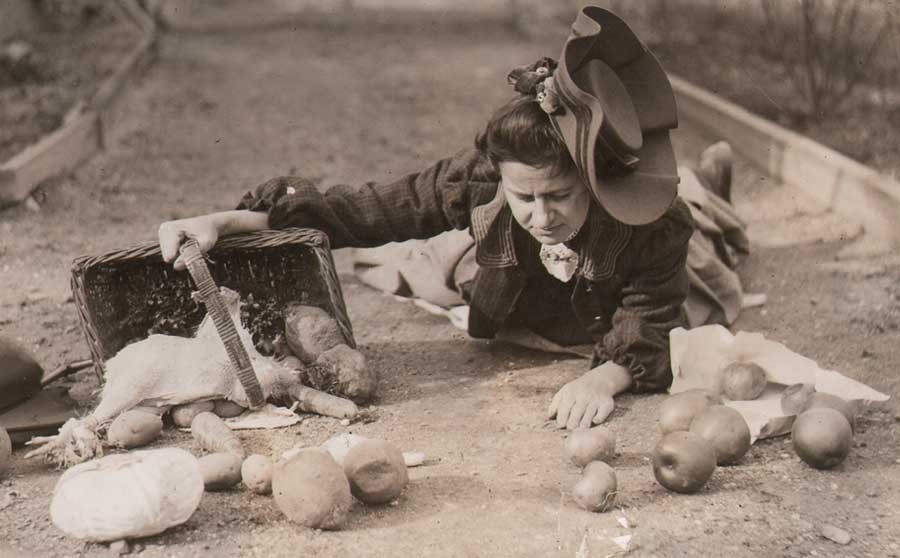
Detail: “Oh, Dear, My Thanksgiving Dinner!” c. 1907 by Jeanette Bernard: American, (1855-1942) gelatin silver print, 15.6 x 20.0 cm, c. 1935-40 or before from original glass plate negative acquired by Culver Service: from PhotoSeed Archive

Detail: “Oh, Dear, My Thanksgiving Dinner!” c. 1907 by Jeanette Bernard: American, (1855-1942) gelatin silver print, 15.6 x 20.0 cm, c. 1935-40 or before from original glass plate negative acquired by Culver Service: from PhotoSeed Archive
Photography up to our modern day is by definition “Drawing with Light”, whereby the permanent recording of an object is achieved via electronic or chemical action. Simplistically this makes sense, but in order to make the outcome relevant and interesting enough to matter, especially in our visually overloaded present, practitioners to put it mildly need to include a bit of heart and soul into their efforts.

Detail: Linoleum cut: “Family in an Explosion of Light” : (20.5 x 18.8 cm impression | 28.9 x 25.0 cm paper) 1925 print by Emery Gondor, American (b. Hungary) : included in unpublished folio: “Sehnsucht nach Licht” (Yearning for Light) : “8 Original Linoleum schnitte von Emerich Göndör” (8 original Linoleum cuts by Emerich Göndör) from: PhotoSeed Archive
Emery Gondor (Emerich Göndör: 1896-1977) had these last two qualities in abundance. A Hungarian artist of prodigious talent who worked in multiple artistic disciplines including photography, the recent acquisition by this archive of some of his signed 1925 linocuts prove a teachable moment for why the manipulations of light and dark in another medium are instructive for creative souls in the present.
Some background, including the reality and history of turbulence in early 20th Century Europe, are critical to our understanding in how artists like Gondor could not be defeated by hatred which destroyed millions of lives and split apart society’s fabric there.
Indeed, his empathy for those shattered lives were taken to heart in the aftermath of his three and a half year service as a soldier in World War I which changed his life forever. Combined with his interest in progressive art education for children discovered in the early 1920’s while attending Vienna’s Academy of Industrial Arts and his work with emotionally disturbed children at the University Clinic there gave him an outlet and purpose for artistic expression, and would culminate towards the end of his career in the 1960’s as director of the art program at the Institute for Mental Retardation at New York Medical College (today : Westchester Institute for Human Development) after earning a degree in Clinical Psychology from New York State University. (1.)
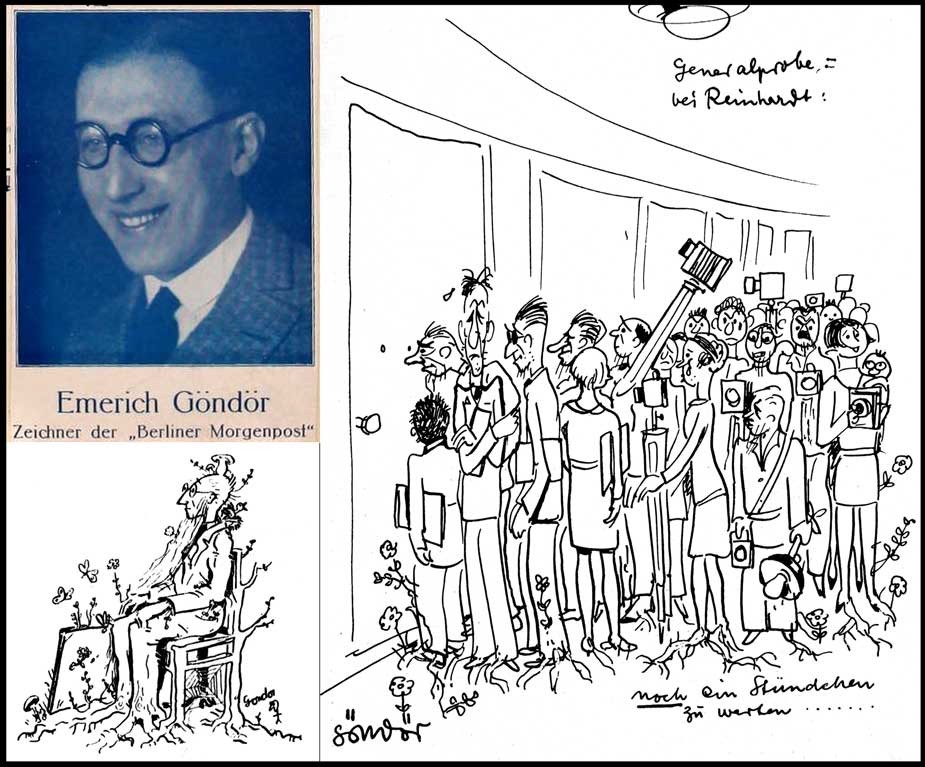
Upper left: 1929 photograph of Emery Gondor when employed as artist for Berliner Morgenpost newspaper in Germany. Bottom left: humorous caricature from early 1920’s shows the artist seated with legs growing into the ground like roots. His cartoon poking fun at an interminable wait to see an editor at Berlin’s Ullstein Verlag publishing house earned him a twelve year career there, where he excelled in multiple artistic disciplines including press photography with theatre subjects a specialty. Right: cartoon titled “Generalprobe bei Reinhardt” (Rehearsal at the Reinhardt) shows the artist (first figure standing at left wearing glasses) along with other members of the press waiting outside the Deutsches Theater to be let in for a press review. The drawing appeared in the May, 1930 issue of Blätter Des Deutschen Theaters. (Journal of the German Theater of Berlin) Surreally, the first name in a contributing, alphabetical list of well known actors, artists, writers and composers for the issue was Benno von Arent, an art director and production designer who became a ranking member of the Nazi SS responsible for art, theatres and cinema for Hitler. sources: portrait and theatre cartoon: Series V: Clippings and Scrapbooks, 1909-1935: Emery and Bertalan Gondor Collection; Leo Baeck Institute; lower left: illustration from graphic arts journal PM, 1936: New York: “Mr. Gondor comes to America”.
In an 1936 artist profile published in the graphic arts journal PM Magazine soon after his immigration to the United States from Europe, Emery Gondor writes:
“But my real interest and love is children. I illustrated many children’s books for the “Union Verlag” Stuttgart, the biggest children’s publishing house, and other youth-publications.” …I made up many hundreds of games for children, puzzles for adults, comic strips. I exhibited again and wrote many articles about humorous observations of children. I always received hundreds of fan letters from my children friends.” (2.)
The Germinal Circle
As a young artist living and just getting by in Vienna after WWI, Gondor did not shy away from progressive ideas as well as the opportunity to sell his original artwork while promoting himself. Traveling to London in late 1923, he did live caricature sketches of poems read aloud by their authors on November 5th and 23rd as an invited guest of the Germinal Circle. Organized by the Italian anarchist Silvio Corio and his lover Sylvia Pankhurst, a like-minded British writer whose mother Emmeline Pankhurst was the leader of the British suffragette movement, the circle was an artistic and literary salon for their short-lived political and cultural monthly magazine Germinal founded the same year. (3.)

Although better known as an artist, Emery Gondor was an accomplished photographer whose work appeared in some of the largest European newspapers (principally German) from the mid 1920’s into the 1930’s. Work contained in his archive at the Leo Baeck Institute in New York City shows a talent equally adept at documentary in addition to staged subject matter including theatrical. Hartmuth Merleker, his former editor at the Ullstein newspapers Tempo and Berliner Montagspost, describes Gondor as not only an artist but a press photographer for the publications between 1929-1933. After learning his grandfather was a lithographer and father an engraver, an excerpt from his 1936 profile by the artist states further on the subject of photography: “I have always had an interest in the problems of reproduction technique. I learned press-photography too. In a short time I learned all the chemical and technical details. I worked one year for the “B.Z. am Mittag,” the quickest German daily paper, as press photographer, and in accordance with my plan Ullstein built eight dark rooms for their daily paper photo service.” Photographs by Gondor shown here: left: photomontage likely from the late 1920’s of a theatrical subject. It likely appeared in one of Ullstein’s German publications. Right: documentary subject of street musicians from early 1930’s Europe or possibly 1940’s New York; with Gondor’s red-ink New York City stamp on print verso. Sources for both: Emery I. Gondor Collection; AR 25397; Box 2; Folder #49; Leo Baeck Institute.
Several of Gondor’s original linocuts, including one incorporated into an advertisement showing a figure with outstretched arms standing next to a grouping of over-sized flowers facing emanating sun rays were reproduced as part of promotional literature in Germinal. The artist from this period is described in a typescript document held with the reproduction in the library of the Leo Baeck Institute in New York City:
The Germinal Circle has pleasure in introducing the work of Emerich Gondor, a young Hungarian artist, who has not previously exhibited in this country. A rapid caricaturist and cartoonist, he works with equal facility through lithography, wood-cuts, lino-cuts and many other mediums. (4.)

Left: detail: 1923 linoleum cut in two colors by Emery Gondor used as program advertisement for the Germinal Circle art salon’s “Second Evening Exhibition of Drawings and Cuts which took place at the Ashburton Restaurant in London on November 28, 1923. source: Emery and Bertalan Gondor Collection; Leo Baeck Institute. Right: detail: same illustration with impression pulled in 1925 (20.5 x 18.8 cm ) used as cover maquette for Gondor’s unpublished folio: “Sehnsucht nach Licht” (Yearning for Light) : “8 Original Linoleum schnitte von Emerich Göndör” (8 original Linoleum cuts by Emerich Göndör) from: PhotoSeed Archive
Sehnsucht nach Licht: Yearning for Light
Emery Gondor’s style in his surviving linoleum cuts from the early 1920’s were certainly influenced by the German Expressionists, and of the heartbreak and for many, hope in the aftermath of the first World War. With emotional joy and pathos rendered in exaggerated strokes of light and dark, the symbolism of the sun and its streaming rays reaching out to embrace humankind is duly represented by his hopeful thematic subjects among others including a family, baby, old man, a blind man, and prisoner locked in a cell as well as the artist himself in signed impressions, several of which are seen here.
The original 1925 cover maquette linoleum cut by Gondor, featuring the aforementioned figure with outstretched arms, has the hopeful title Sehnsucht nach Licht . (Yearning for Light) Featuring eight original linoleum cuts with the themes outlined above, the work is not believed to have been published other than several copies, although seven of the eight plates as well as the maquette can be found here on this website as well as the full compliment and other examples of Gondor’s artwork from his career at the Baeck Institute online site.
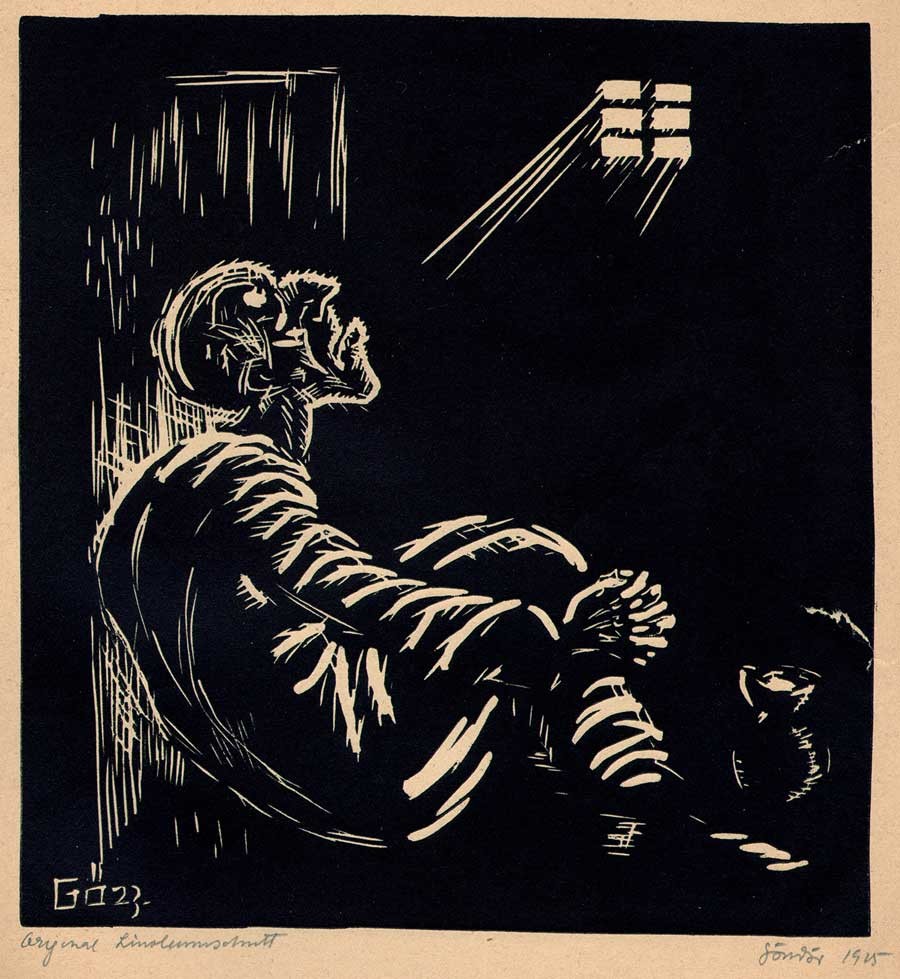
Detail: Linoleum cut: “Old Prisoner gazing at the Light” : (20.0 x 18.7 cm impression | 28.5 x 25.0 cm paper) 1925 print by Emery Gondor, American (b. Hungary) : included in unpublished folio: “Sehnsucht nach Licht” (Yearning for Light) : “8 Original Linoleum schnitte von Emerich Göndör” (8 original Linoleum cuts by Emerich Göndör) from: PhotoSeed Archive
Sobering, but Necessary
Eventually, Gondor’s talents paid off. Besides honed artistic chops, abundant energy, charisma and a sunny disposition as evidenced by his ever-present smile seen in surviving photographs, he attained the title of Art Director for the Ullstein Verlag publishing house of Berlin, the largest concern in Europe. But then in 1933, the Nazis came, he wrote in the 1936 PM profile, and everything changed and was lost. In September of 1935, Gondor’s former editor Hartmuth Merleker of the Ullstein newspapers Tempo and Berliner Montagspost wrote a glowing review of his talents which spoke of this fine character giving him the needed credibility in the eyes of German authorities and the right to emigrate for his new life in America:
“He worked mainly as comic and propaganda artist and as a theater photographer and absolved himself to everyone’s satisfaction. He tactfully refrained from attending any non-artistic, non-photographic activities, and as a Hungarian citizen was never known to abuse the right to hospitality he enjoyed in Germany to Germany’s disadvantage.” (5.)
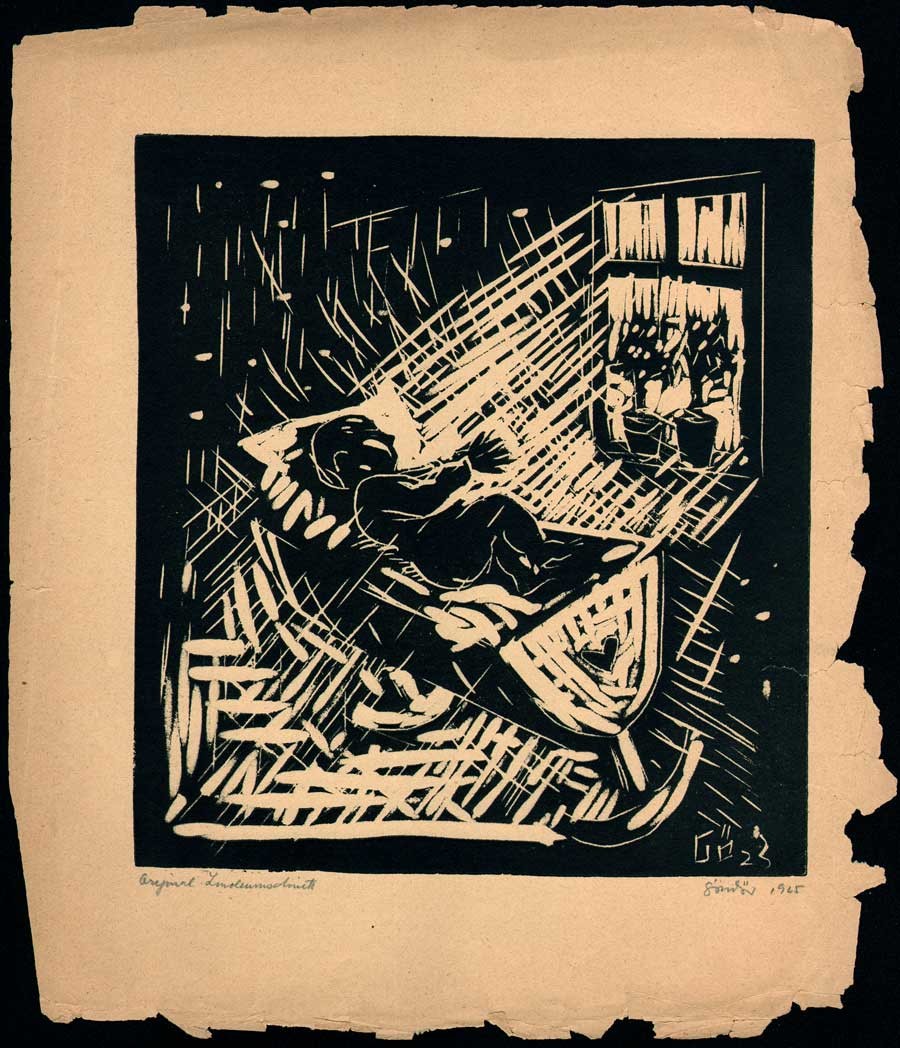
Linoleum cut: “Child in an Explosion of Light” : (20.5 x 18.8 cm impression | 28.9 x 24.8 paper) 1925 print by Emery Gondor, American (b. Hungary) : included in unpublished folio: “Sehnsucht nach Licht” (Yearning for Light) : “8 Original Linoleum schnitte von Emerich Göndör” (8 original Linoleum cuts by Emerich Göndör) from: PhotoSeed Archive
Sobering in hindsight of course. What true artist in their own mind could “tactfully refrain from “any non-artistic, non-photographic activities” during the course of his or her work? Fortunately for us, Emery Gondor had a bit of luck going his way as well, with earlier examples of his artistic legacy preserved here for posterity and later career achievements benefiting those children he helped and inspired a testament to the abundant light emanating from his own oversized heart and soul.
David Spencer- October, 2015
Notes:
1. background: Emery Gondor: Biographical/Historical Note: from: Emery I. Gondor Collection: Leo Baeck Institute online archive accessed Oct. 2015. In Gondor’s 1954 application to publisher Doubleday for his book Art and Play Therapy published the same year, it stated he “is a sensitive clinician of long and varied experience. Early in his career he had no intention of becoming a psychologist or psychotherapist, but began as an artist and teacher of art after attending the Royal Hungarian University and receiving his diplomas from the Federal Academy of Art in Budapest. As a young art teacher, however, he was faced with the misery of children who suffered tremendously during and after the first World War, and felt that he had to understand more about their problems in order to be able to help them. Thus began his interest in the study of psychology.”
2. PM: 1936: Mr. Gondor comes to America: p. 7
3. Germinal, a quarto monthly ran for two issues in July, 1923 and one other unknown issue published in 1924. “This illustrated journal published fiction by Gorky, drama by Ernest Toller, poetry by Alexander Blok, by Anna Akhmatova and by Pankhurst.” see: Morag Shiach: Modernism, Labour and Selfhood in British Literature and Culture, 1890-1930: Sylvia Pankhurst: labour and representation: 2004: p. 103
4. see: The Germinal Circle: Leo Baeck Institute Archives: New York: Folder 1/16: Call number AR 25397
5. translated, hand-written copy of Sept 7, 1935 letter by editor Hartmuth Merleker contained in Leo Baeck Institute online archives.
Surreal would be a good word for it. On the evening of Friday, November 4, 1904, the touring company of the Broadway flop Eben Holden made its way to a performance at a building called the Auditorium on S. 2nd Street in downtown Newark, Ohio.
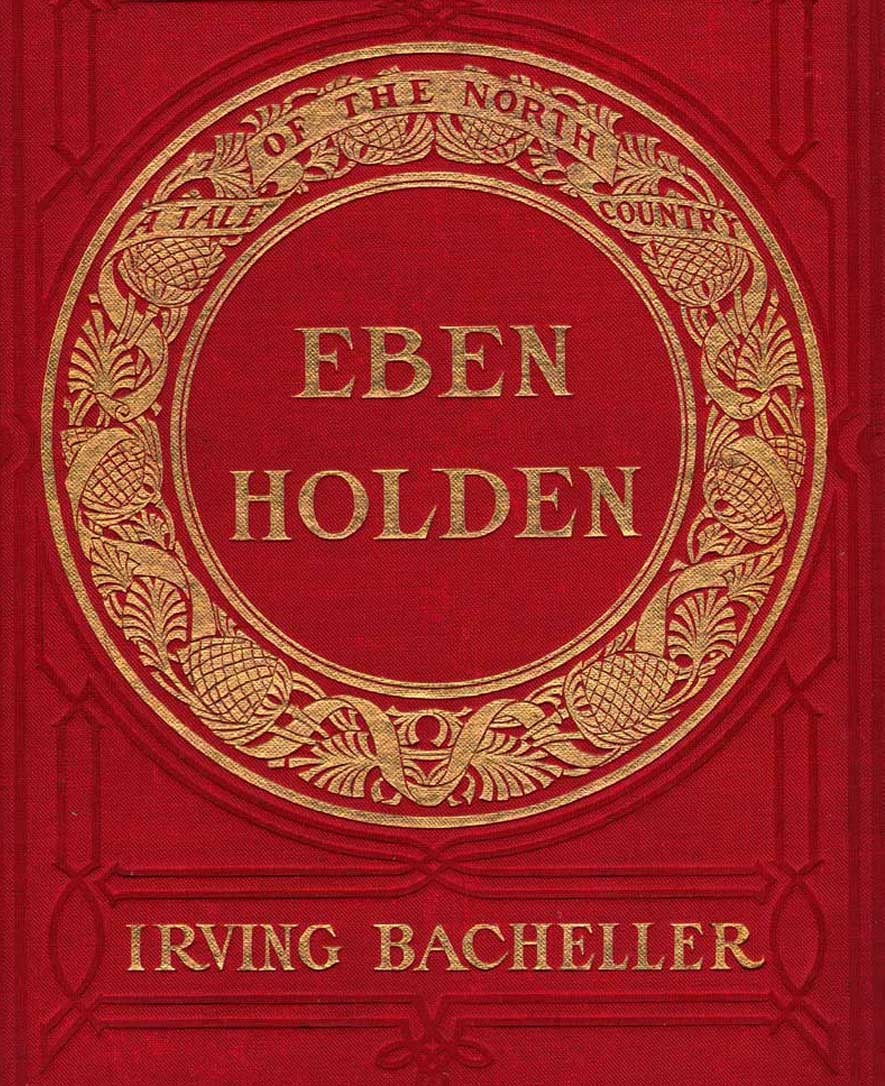
Detail: Cover for “Eben Holden: A Tale of The North Country”: Edition de luxe by Irving Bacheller. Lothrop Publishing, Boston: 1903. Gilt-engraved decorative cloth with circular design featuring a design of a ribbon interlaced with pinecones and leaves: 21.0 x 14.2 cm: One of the best selling novels from the very beginning of the 20th Century, this edition features 12 photogravure plates by photographer Clarence Hudson White. from: PhotoSeed Archive
Most likely in attendance that night? Clarence Hudson White, (1871-1925) the world-renowned pictorialist photographer who was a recent founding member of the American Photo-Secession and current Newark resident. Only two years earlier, he had taken a series of photographs using his Newark neighbors as models for a special edition of Eben Holden that had been made into this very play.
Written by American journalist and author Irving Bacheller, (1859-1950) the story is a classic rags to riches tale that captivated the masses in the new American century when first published in July of 1900, eventually selling over 1 million copies. The setting at the beginning of the novel is the “North Country” of Northern Vermont , the Adirondack’s and St. Lawrence River Valley of the 1840’s and 1850’s. It tells the coming of age story of William Brower, orphaned at the age of six after his parents and older brother accidentally drowned as well as his relationship with Eben Holden, a farm hand who rescued “Willy” from the cruel fate of an orphanage
But this post is part collecting story, a kind of hunt for treasure, or “spondoolix” as “Uncle Eb” would say in one chapter-his country ways and lack of education brought into sharper focus for the reader by Bacheller’s liberal usage of Holden’s spoken dialect.
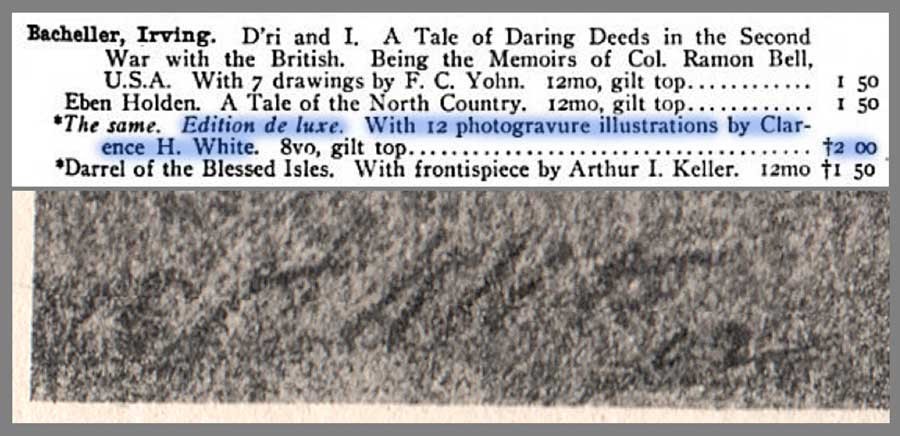
Detail: Top: listing for works by American author Irving Bacheller showing Edition de luxe of Eben Holden highlighted in blue: from: Illustrated Catalogue of Books Standard and Holiday 1903-1904: Chicago: A.C. McClurg and Company: 1903: p. 217 (the † denotes it is a work of fiction, published since November 1, 1902, under the rules of the American Publishers’ Association. (from: Hathi Trust)Bottom: close-up detail showing autograph for CH White 02 at bottom left corner of representative photogravure plate from the Edition de luxe: from: PhotoSeed Archive
The Hunt is on
I consider myself a newbie collector, but one of the first things I put on my list 15 years ago when I first started out was one particular impression of Eben Holden rumored to have been illustrated by hand-pulled photogravures by White, the aforementioned famous photographer.
My curiosity had been piqued after seeing the volume listed in several bibliographies, typically stating the 1900 date. One such entry in author Christian A. Peterson’s Annotated Bibliography on Pictorial Photography did give me hope the work existed, even though finding one in the internet age would prove to be quite the challenge:
The Museum of Modern Art, New York, holds what is probably a unique copy of this book, comprised of the Lothrop text pages bound in leather, with an inscription by White and ten photogravure illustrations by him, including the portrait of Holden. (1.)
Because the novel had been such a success a century earlier, the reality of upwards of 500 vintage copies for sale on the web at any one time was daunting. My course of action however was simple, and eventually effective: send out a mass number of emails to every bookseller in the U.S. listing a copy from a suspect 1901 edition I had honed in on inquiring if it contained any photographic illustrations.
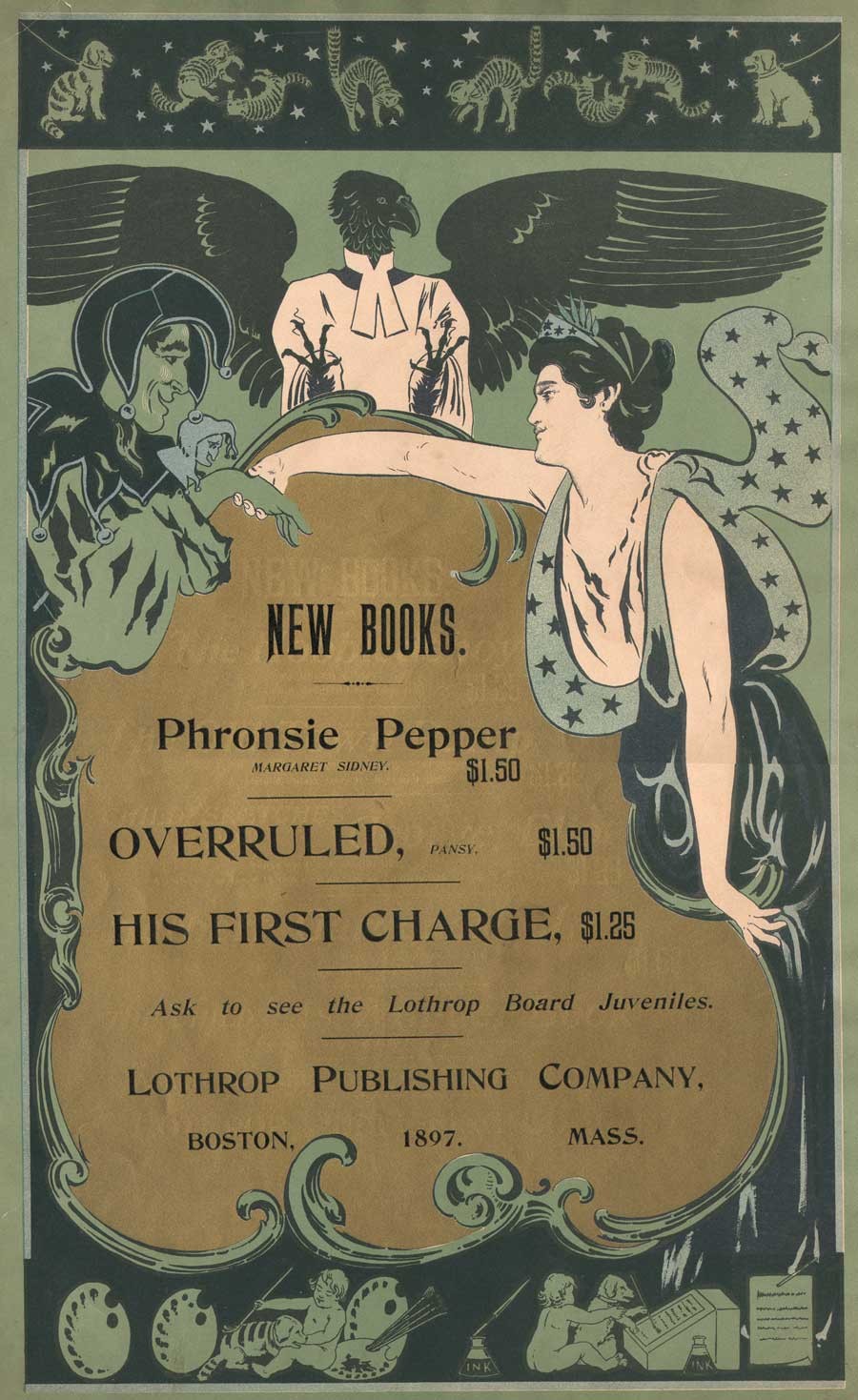
Broadside advertising poster for Lothrop Publishing Company of Boston: 1897: artist: William Schumacher: American: (1870-1931) multiple-color lithograph printed on wove paper: 52.7 x 34.0 cm. Speaking of the beginnings of Eben Holden in the year 1897, author Irving Bacheller said “had unsuccessfully offered the first ‘Eben Holden’ as it then stood to two juvenile publications; but as I happened to be just starting off on a vacation at that time, I determined myself to see the Boston firm, which was the Lothrop Publishing Company. I met the editor, Mr. Brooks, at the Parker House, and told him the story as I had written it. He immediately saw the possibilities in it and declared I had a big thing if I could carry it out as it should be.” (excerpt: “The Critic”: Oct. 1904) vintage broadside (trimmed) from: PhotoSeed Archive
And so eventually luck prevailed. In 2007, a bookseller in Idaho finally said yes, and a bucket item was now on my library shelf. But that was not the end of it, as Alice would say, things got Curiouser and Curiouser! Because collectors never stop looking, I soon stumbled upon a CT bookseller who knew exactly the significance of the White-illustrated impression, with an astronomical asking price. An excerpt from his description of the work stated:
Elusive and highly desirable work, absent from almost all museum and library collections devoted to photography, and one of only a very few photographically illustrated books produced by a leading member of the Stieglitz circle at the height of the Photo-Secession. (2.)

Top: detail: 1891 advertisement for The Estes Press (Dana Estes & Company) from “The American Bookmaker”. The woodcut shows the brand new Estes Press Buildings located at 192 Summer St. in Boston first occupied around 1890. The firm housed many different companies involved in the bookmaking process, including: “The celebrated engravers, John Andrew & Son have their studios in the upper story…”; J.S. Cushing & Co., (book composition) Berwick & Smith, (presswork) and E. Fleming & Co. (binding). These last three firms left Estes in 1894 and became part of the Norwood Press. (from: Hathi Trust) Bottom: detail: exterior photograph of Norwood Press from the 1897 volume “Boston Massachusetts” by George W. Englehardt. The original caption noted the firm was located “Fourteen Miles from Boston, on the New England Road” and “as a whole employing nearly three hundred hands.” This is where the Eben Holden Edition de luxe was printed. (from: Hathi Trust)
And so I sucked it in and didn’t purchase the second copy, which he told me he had originally purchased in Marlborough, NH. Eventually he sold it to a European collection, but I’ve since visited him several times and made a few purchases over the years, something I highly recommend rather than doing everything through e-commerce.
But then lighting struck again five years ago, when I purchased a second copy which had been personally inscribed by the author in 1911 to John A. Dix, then governor of New York state.
Curiouser? The first copy, fourth edition imprint stated Two Hundred and Sixty-fifth Thousand, March 12, 1901 and the second copy was for Two Hundred and Seventieth Thousand, September 18, 1903.
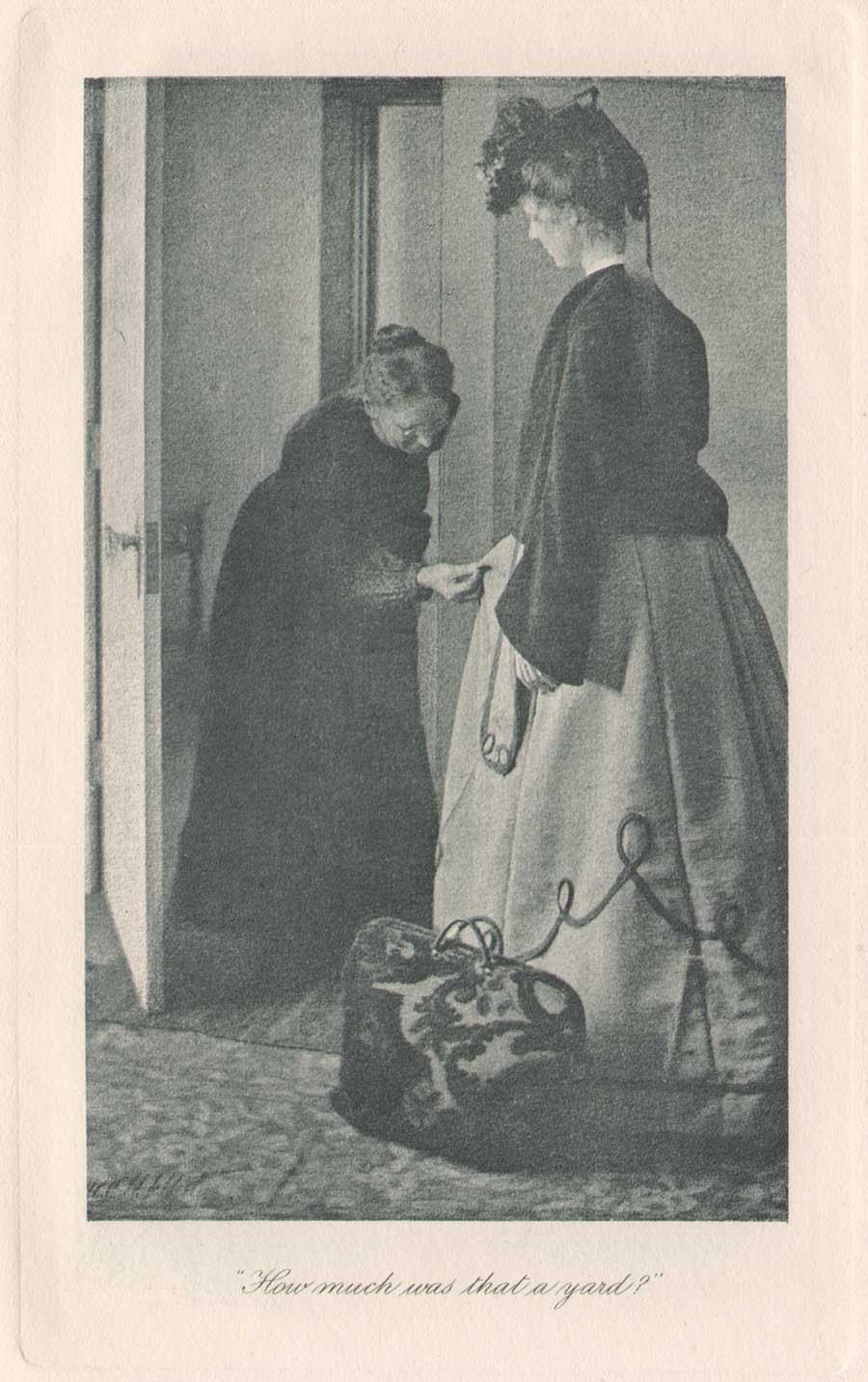
Detail: Clarence H. White: American: “How much was that a yard ?” Hand-pulled photogravure plate printed by John Andrew & Son (image: 12.2 x 7.5 cm | support: 20.0 x 14.0 cm ) from: Edition de luxe impression of Eben Holden: Lothrop Publishing, Boston: 1903. The Library of Congress states the model at right is Ann Fulton and the woman examining the dress is the photographer’s mother Phoebe Billman White (1845-1920) : from: PhotoSeed Archive
Knowing the book now existed in multiple impressions with the Clarence White photogravures was perplexing to me at first, but I’m certain the inclusion of the White photographs was intended by the publisher Lothrop for a more discriminating audience, so its assumed they had the monetary incentive to publish more than the one impression-even with the fickleness and extra work necessary to bind an edition with hand-pulled gravures.
To this end, my research in preparing this post discovered 1901 to be the year Clarence White was first commissioned by the Boston publisher to illustrate a new edition of Eben Holden. The intended publication date of very late 1902 was designed to coincide with the lucrative holiday sales season. Even with the move to e-books in our modern age, publishers earn good money issuing ornate and extra-illustrated editions during this time of year catering to the once a year book buyer and bibliophile alike.
Known as the Edition de luxe, this edition of Eben Holden with the White photogravures priced at $2.00 somehow managed to miss the late 1902 holiday sales season. The curious fact of the inclusion of the imprint for March 12, 1901 on the limitation page and White’s signature including the year 02 on many of the 12 plates in the published work was basic economics for publisher Lothrop-they simply used existing leaves, including the old limitation pages from current stock when it was eventually released for sale to bookstores in 1903.

Top: detail: 1896: advertisement for John Andrew & Son from the “Boston Blue Book”. (from: Hathi Trust) Bottom: detail: typical example of the firm’s engraved credit appearing at lower right corner of image margin on plate recto from the 1903 Photographic Times-Bulletin. The John Andrew firm was established in Boston in 1852. from: PhotoSeed Archive
This was by no means unprecedented by Lothrop, or other large publishing houses of the era, as they would have set aside a certain number of unbound sheets from a best-selling work for limited impressions featuring artwork. The first illustrated edition of Eben Holden featured halftone photographs taken by Joseph Byron from the Broadway production of the same name hadn’t even debuted until Oct. 28 of 1901. This also used the March 12, 1901 imprint date. Known as the Dramatic Edition, it was described in the trade monthly The Bookseller:
“An illustrated edition of Eben Holden has been recently published called the Dramatic edition. It contains seven pictures of the play as it appeared in New York and a fine portrait of the author.” (3.)
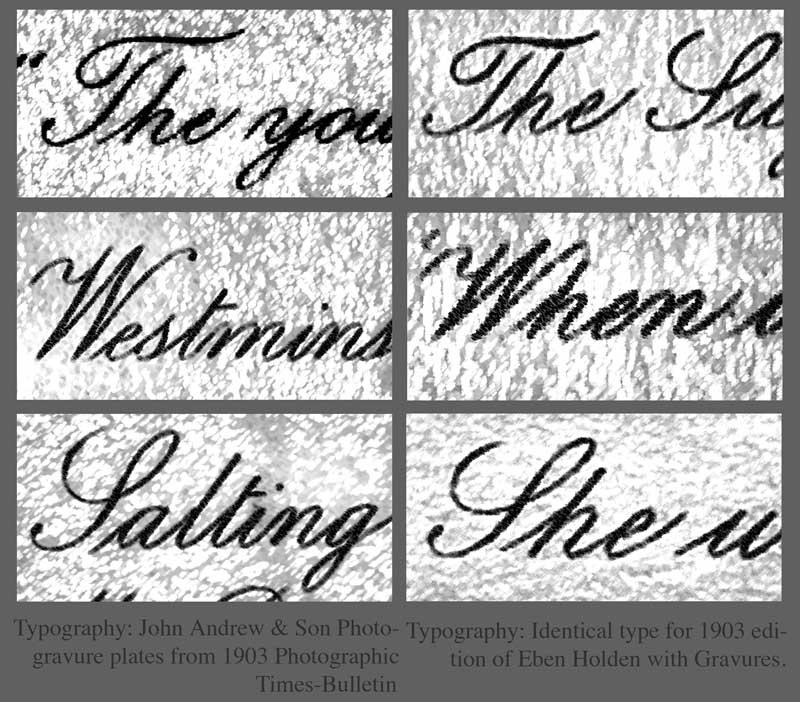
Details: with manipulations in PhotoShop to highlight typography: In order to show Boston’s John Andrew & Son atelier printed the photogravure plates uncredited in the de luxe edition of Eben Holden, it is useful to analyze the script font typeface used for photographic plate titles. Column at left, top to bottom shows known examples from the Andrew atelier taken from the 1903 Photographic Times-Bulletin. Column at right shows plate titles from the Eben Holden volume. all from PhotoSeed Archive.
Published in 1903
Finally, with the eventual tenth imprint of the fourth edition stating Two Hundred and Seventieth Thousand, September 18, 1903, (6.) the makeup of the Edition de luxe was that of a small 8vo Octavo instead of the common edition, a 12mo Duodecimo. The inclusion of 12 fine, hand-pulled photogravure plates by White seen here is another matter altogether. For one, other than White’s autograph-appearing often (and faintly) in the lower left hand corner of each plate image as CH White 02, the Edition de luxe neglects to give him any printed credit for the photographs nor the atelier who printed them. This is very surprising for a special edition. Typically, there would at the very least be a separate illustrations page noting titles and page numbers at the front of a similar volume, but for whatever reason they were not included.
Stieglitz plays Go Between
With Eben Holden’s great success, the dramatization of the novel on the Broadway stage was logical for its day-especially since the Cinema was not an option because of the infancy of the medium. Lothrop’s piggy-backing of the work through this Dramatic edition, even by the “flop” standard of 49 performances, was but one way of keeping the work “fresh”- even a full year after initial publication. At some point late in 1901, a result perhaps of someone seeing the play on Broadway or believing White’s work would lend itself nicely to a series of photographic illustrations, the Boston publisher-perhaps through an association with Fred Holland Day (who lived in nearby Norwood where the Norwood Press printed books for Lothrop) or Alfred Stieglitz in New York-gave White the commission for its second illustrated edition of the novel.
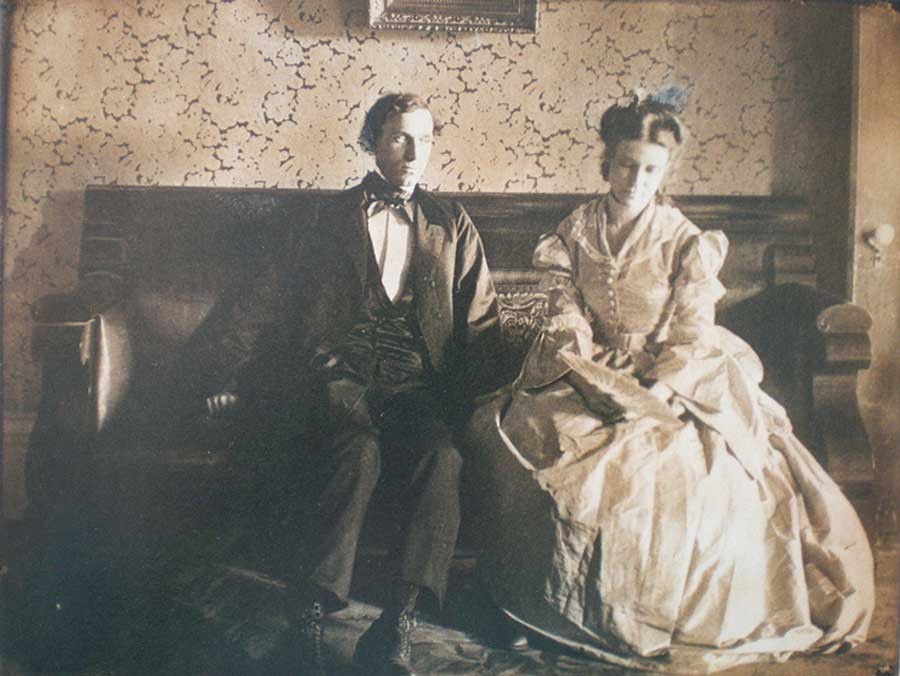
Clarence H. White: American: 1902: “She was still looking down at the fan”: vintage Platinum or gelatin silver print: Showing typical retouching by White, the models are Alfred Dodge Cole, (1861-1928) a professor of Chemistry and Physics at Denison University and his wife Emily Downer Cole. (1865-1957) They play the roles of William Brower and Hope, whom Brower eventually marries in the novel Eben Holden. The photograph was reproduced as a photogravure plate and included in the Edition de luxe. Curators at the Robbins Hunter Museum where this and other White photographs are held stated the photographer had taken family photographs of the Downer family on the lawn of the home in the late 1890’s and so he “would have been familiar with the house and furnishings from that commission. It was common for Clarence White to ask acquaintances to pose for photographs, often in costumes that he would provide. The photographs for Eben Holden were staged with costumes from the Civil War era.” Photograph courtesy: Collection of the Robbins Hunter Museum in the Avery Downer House, Granville, OH.
Ultimately, Stieglitz’s publishing background, connections and established relationship with White through his editorship of Camera Notes, his new involvement with Camera Work, as well as his having his own work exhibited in an early salon of pictorial photography in Newark Ohio in late 1900 and other exhibitions made Stieglitz a believer in White’s potential as an illustrator:
“What is especially fascinating, however, is what occurs when White is commissioned, as he was in 1901, to take up literary illustration himself. Through the assistance of Stieglitz, White received the commission to illustrate a new edition of the novel Eben Holden by Irving Bacheller. ( 4. )
And much later, the photographer’s grandson Maynard Pressley White commented about a bit of reluctance on his grandfather’s part in dealing with Lothrop as part of his Ph.D. dissertation in 1975:
“The correspondence with Stieglitz concerning the illustrations for Eben Holden is revealing of his character as well as Stieglitz informed him that he suffered from no such timidity and would–and indeed did–handle the matter with the publishers, as it turned out, to the advantage of White.” (5.)
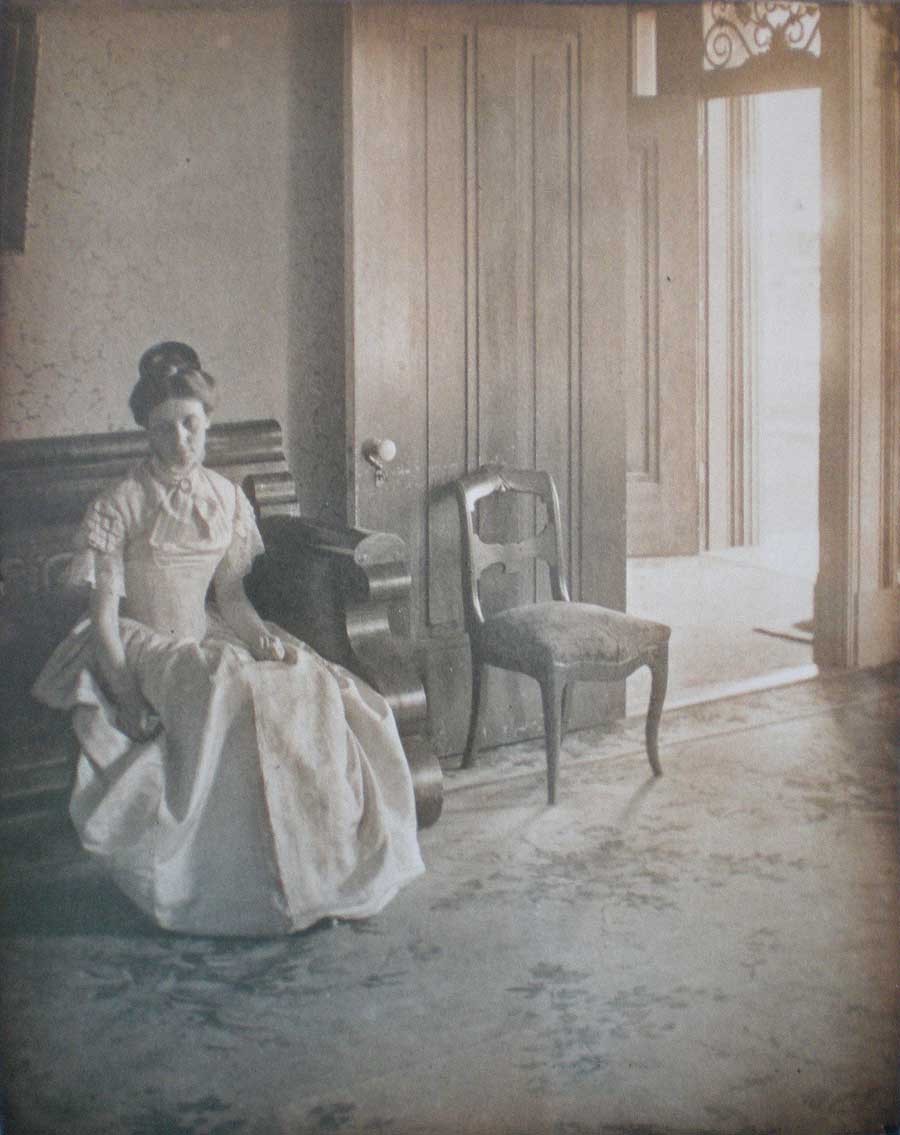
Clarence H. White: American: 1902? : vintage untitled Platinum or gelatin silver print: The model Emily Downer Cole (1865-1957) poses wearing a different dress than seen in the published Eben Holden photogravure “She was still looking down at the fan” taken on the same settee in the front parlor of the Downer family home. This was likely an alternate study Clarence White took for consideration for his series of Eben Holden illustrations. Photograph courtesy: Collection of the Robbins Hunter Museum in the Avery Downer House, Granville, OH.
John Andrew & Son: founded in Boston: 1852
In giving credit to White and the firm that printed his photographs as gravures, a bit of elucidation seems in order to set things straight. Upon close inspection of these plates along with many others by Boston’s John Andrew & Son from the same time frame, I feel confident giving the Andrew firm credit for printing them. This is based on a near exact match in the script font used for the plate titles in the de luxe edition of Eben Holden as well as those plates credited to the firm appearing in the Photographic Times Bulletin from 1902-04.
I’ve included examples of the font as a comparison with this post. Another exact match is the same plate paper was used for both publications: this is very revealing especially on the plate verso where a very fine stipple pattern can be seen on the paper surface of the cream-colored plate paper. Perhaps the strongest association with the John Andrew atelier and the Norwood Press (which printed the de luxe edition) emerged in my research on business associations with some of the individual companies that came together in 1894 when that press was formed. These included J.S. Cushing & Co., (for composition and typesetting) Berwick & Smith Co., (for presswork) and E. Fleming & Co. (for binding). Beginning around 1890, all of these firms along with John Andrew were under one roof as part of the brand new Dana Estes & Company publishing house buildings on Summer Street in Boston.
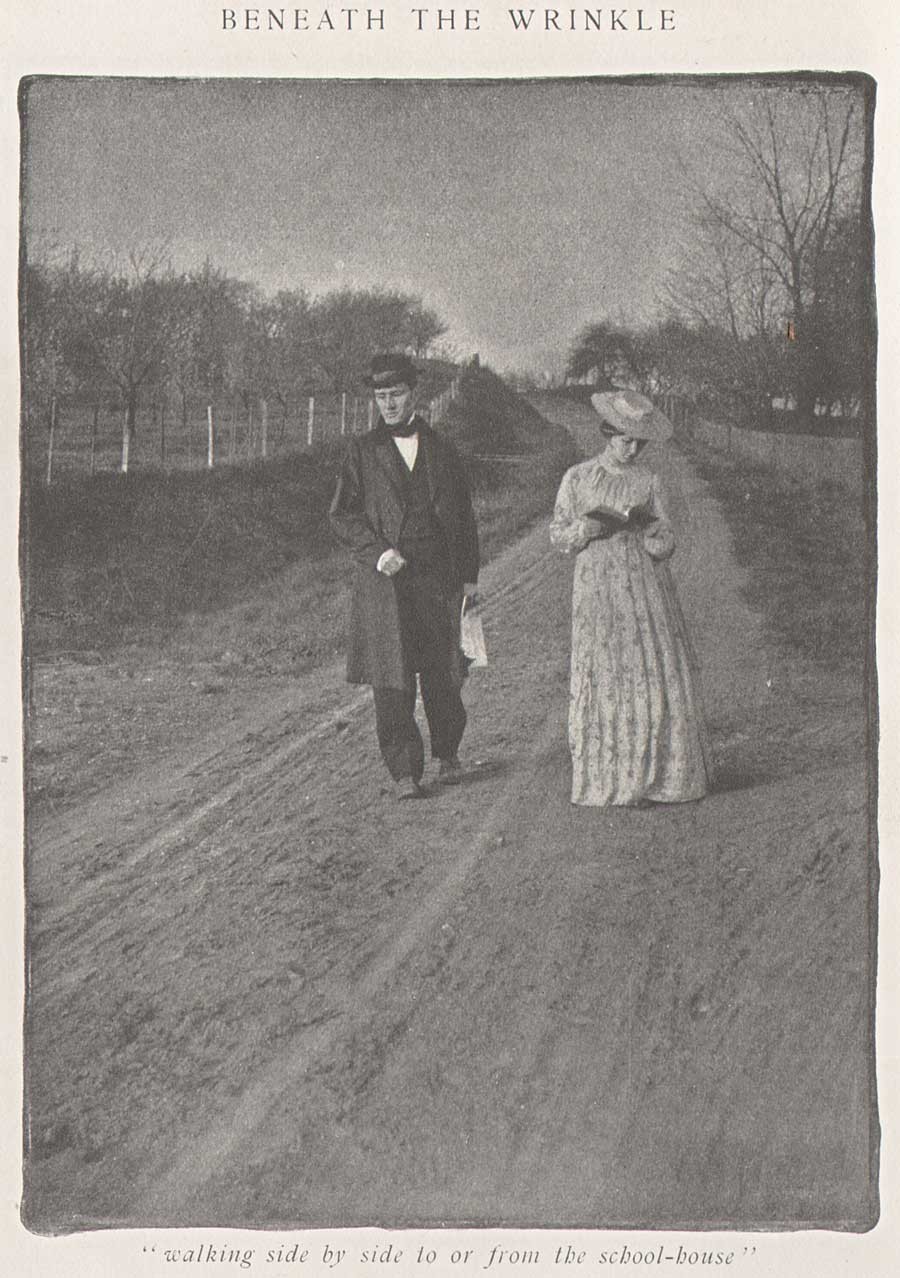
Clarence H. White: American: 1903: halftone: “Walking side by side to or from the school-house” was one of three photographs published to illustrate the Clara Morris story “Beneath the Wrinkle” published in the February, 1904 issue of McClure’s Magazine. (12.8 x 9.5 cm) published: p. 430. From: PhotoSeed Archive
With the move to Norwood in 1894, the Andrew atelier stayed behind in Boston at 196 Summer St. but continued to provide fine photo engraving work to the major publishing houses in Boston and New York. Known today for printing many of the photogravure plates beginning in 1907 for the monumental Edward Sheriff Curtis work The North American Indian, the firm sometime in the first decade of the 20th Century became a department of the Suffolk Engraving & Electrotyping Co. of Boston with offices at 394 Atlantic Ave.
Named after John Andrew, (1815-1870) a wood engraver born in England who immigrated to Boston where he worked with fellow engraver Andrew Filmer, the firm eventually made the transition to photo engraving, including the half tone and photogravure processes. Andrew’s son George T. Andrew succeeded his father at the business, located at 196 Summer St. An 1892 overview of the firm from the volume Picturesque Hampden gives some background:
JOHN ANDREW & SON COMPANY.
ENGRAVERS AND MAKERS OF FINE BOOKS, BOSTON MASS.
If we go back a few years, we find that in illustrating books and magazines wood and steel engraving were about the only methods available. Nor could steel engraving have any wide use on account of the great expense of printing. Ever since its start, in 1852, the firm, now styled the John Andrew & Son Company, has held a prominent place among illustrators, especially in work of the finest grades. Their reputation was made in the first place as engravers on wood, but the discovery of delicate chemical and mechanical processes has in later years led them to also take the photo-engraving and half-tone work which has at present such wide use and popularity. In this field they do work for some of the best magazines and books published in this country. In what they undertake they strive not so much to do the cheapest work in price as the best work in quality. Quite recently the firm has taken up the photo-gravure process in addition to those spoken of above. The industry we describe is not located in Hampden county, but the mention here is not inappropriate as the engraving of our pen and ink pictures was done almost wholly by this firm. Their address is 196 Summer street, Boston.
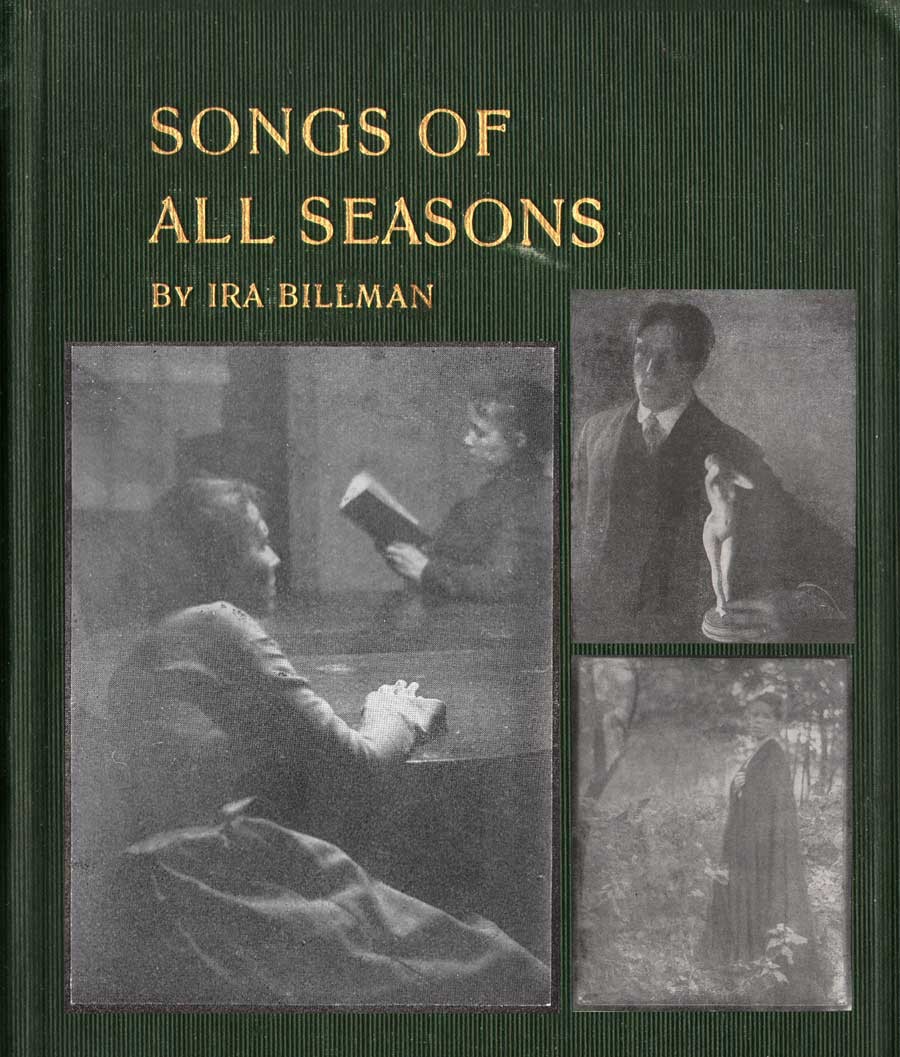
Detail: Cover for “Songs of All Seasons” by Ira Billman. The Hollenbeck Press, Indianapolis: 1904. Gilt-engraved stamped cloth: 20.4 x 13.6 cm: shown inset with representative photographs taken by Clarence White reproduced in halftone in the volume. Photo left: “The Book Lovers” (p. 181); top right: untitled man with statuette illustrating poem “The Twin Flower” (p.137); bottom right: “The Gloaming” (p. 199). Billman was Clarence White’s uncle and was “one of his earliest artistic influences in his life”: From: PhotoSeed Archive
Photographic Illustration: a New Outlet
A newspaper clipping, believed to be from the Newark Daily Advocate in the Clarence Hudson White clipping file at the Newark, OH public library, includes the following undated (but 1903) story discussing Eben Holden in passing while concentrating on a new commission that inevitably came from it: costume-piece photographs by White similar to those he did for Lothrop for author Clara Morris’s story published in McClure’s magazine in February, 1904 entitled “Beneath the Wrinkle“:
PICTURES From Real Life by Clarence White
Forwarded On Order to a New York Magazine-Local Artist’s Latest Work.
Mr. Clarence White received a command last fall from the art department of McClure’s Magazine to illustrate Clara Morris’ new story, entitled, “Beneath the Wrinkle,” that will appear in that magazine presumably in the near future. Mr. White was to have been given all the time he wanted, but in view of the change of art editors, Mr. White was notified about three weeks ago that the illustrations would be required immediately. Mr. White at once notified the publishers that he would use all his efforts to complete them immediately, and would forward them when completed. Today the set comprising six, were forwarded and as equaly as clever and well executed as the ones made for the illustrating of the holiday edition of Eben Holden that was to have made its appearance last Christmas, but was not completed in time for that season. The ones now in progress are all local personages, done in quaint, old-fashioned garb and surroundings, recalling vividly to mind the characteristics in dress and decorations then in vogue. They show the fine and beautiful artistic temperament of Mr. White in his striking correct interpretation of dress and customs of the period in which the characters live. Mr. White deserves the honor the illustrations will surely bring to him, as he is always conscientious and painstaking in whatever he undertakes in his profession.
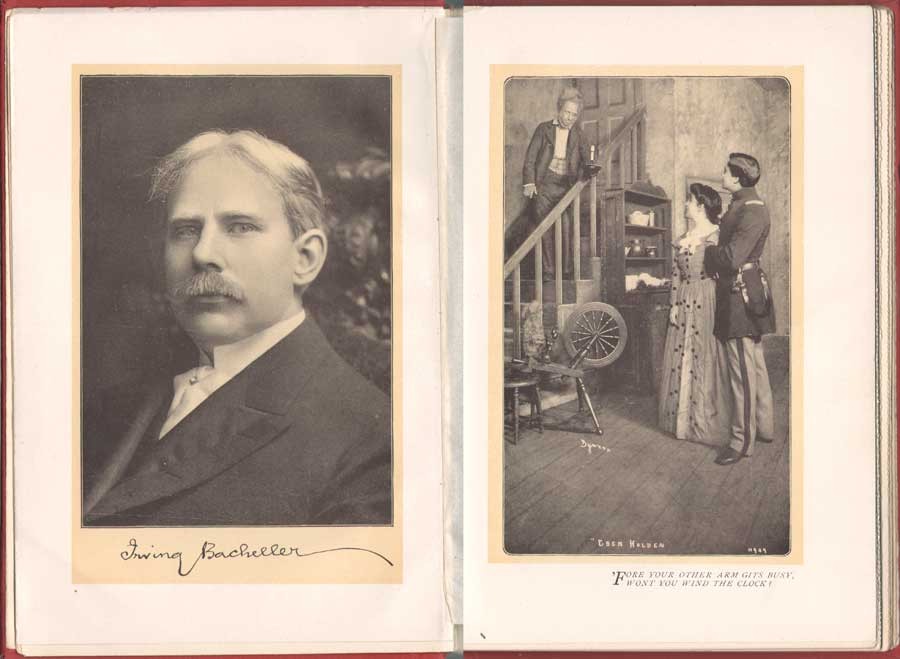
Left: Irving Bacheller, (1859-1950) American journalist and author, wrote the novel Eben Holden which sold over 1 million copies. This portrait with facsimile autograph by an unknown photographer appeared as the frontis (13.3 x 9.1 cm) to the Dramatic Edition of the book-the first illustrated edition featuring photographs of the Broadway stage production that debuted Oct. 28, 1901 and ran for only 49 performances. Right: ” ‘Fore your other arm gits busy, wont you wind the clock?” (14.1 x 8.4 cm) Actor E.M. Holland at left plays the role of Eben Holden, Lucille Flaven plays Hope and Earle Ryder as an American Civil War officer plays William Brower. The important New York commercial photographer Joseph Byron, (1847-1923) founder of the Byron Company (currently, the 7th & 8th generations runs Byron Photography) took stage photographs of the play at New York’s Savoy Theatre with plates published in the Dramatic Edition. from: PhotoSeed Archive
White Family Connections: Songs of all Seasons
During the time he received the commission for illustrating Beneath the Wrinkle in 1903, a more intimate family connection developed which allowed White the opportunity to take another series of photographic illustrations, 42 in all, published in 1904 within a slim volume of poetry titled Songs of All Seasons.
The author was nationally known poet Ira Billman, Clarence White’s uncle, the brother of his mother Phoebe Billman White. In the volume Symbolism of Light: The Photographs of Clarence H. White published in 1977 which accompanied an exhibition of White’s work at the Delaware Art Museum and International Center of Photography, White’s grandson Maynard P. White, Jr. describes Ira Billman as a major influence on Clarence and Songs:
Among the gathering of aunts and uncles that gave meaning and context to the artist’s early life was Ira Billman, his mother’s brother. “Poetic” is the word most often used to describe White’s photography, and his Uncle Ira, a poet by avocation, was one of the earliest artistic influences in his life. …Billman’s work celebrates rural America; his poems are songs to people and to nature, and they are imbued with the deep religious sentiments of his Lutheran heritage, without being mawkish or even faintly cloying. What is important for the purpose of my discussion is that Clarence White made the photographic illustrations for Songs of All Seasons, and Billman dedicated the volume to him. (7.)

“To Governor John A. Dix with many good wishes from Uncle Eb an’ me Irving Bacheller N.Y. Feb. 22 1911.” This personal inscription by Bacheller to John A. Dix, then Governor of New York State, appears in a volume of Eben Holden with the imprint of Two Hundred and Seventieth Thousand, September 18, 1903, the actual year the novel was released for sale. In a 1901 newspaper article, Bacheller said the character Eben Holden was based on “a composite of my father and his hired man-a very jolly old fellow”. from: PhotoSeed Archive
Ninety-one poems and sonnets are included in the volume. Here, The Test, a representative poem from the work:
The Test
Not what I felt will be the test
When song and fragrance filled the hour,
And all the sunshine of the blest
Unfolded me to perfect flower.
Not what I aid will be the test
When by sweet waters wound my way,
And white-haired, thoughtful hills all guessed
The word I was about to say.
Not what I did will be the test
When stunned by cry of human needs
I dreamed I was myself oppressed,
And woke to passion of great deeds.
Not what I chose will be the test
When first I saw one world in hand
Is worth two in the bush-the best
Of which it is to understand.
O! none of these will be the test,
But what God knows I would have done,
Had I been nurtured in the nest
Of one, I now condemn and shun. (8.)
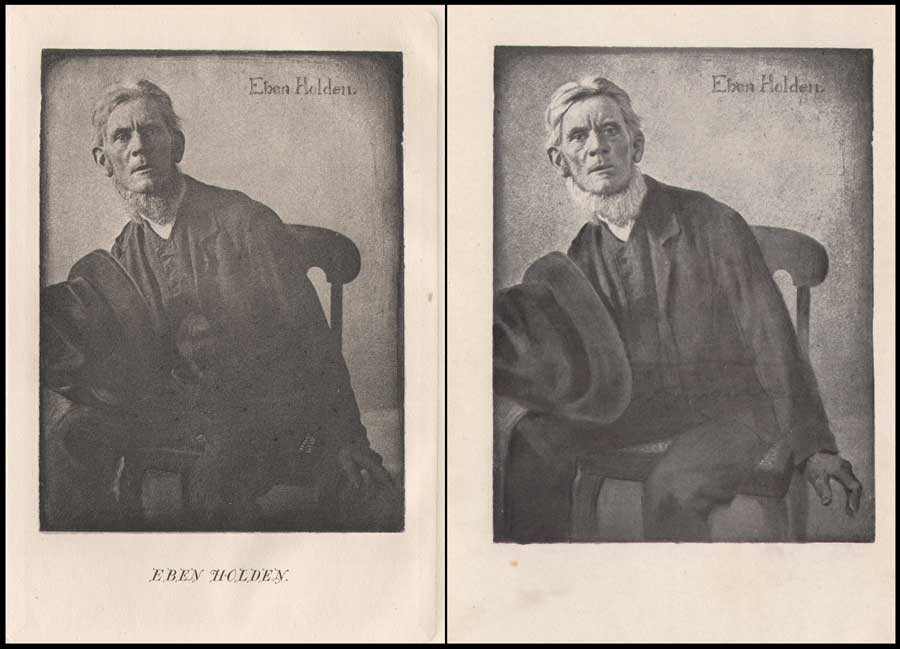
Left: Clarence H. White: American: 1902: hand-pulled photogravure: (9.7 x 7.3 cm) in: Eben Holden: A Tale of the North Country: Boston: Lothrop Publishing. (1903) Appearing as the frontis portrait in the Edition de luxe, this unknown subject was the novel’s namesake: a fictional character who was a former farm-hand and main father figure for the newly orphaned William Brower serving as the narrator in the work. Right: Clarence H. White: American: 1902: halftone: (12.0 x 9.2 cm) in: Eben Holden: Harper & Brothers Publishers. (1914) Part of the Pine Tree Edition of Irving Bacheller’s (Collected) Works. This heavily manipulated portrait from the original photograph by Clarence White of Eben Holden published 11 years earlier also appeared as the frontis for the first volume in the Pine Tree series. From: PhotoSeed Archive
Pictorial Illustration for Photography a Growing Field
By 1904, esteemed critic Sadakichi Hartman, writing in Leslie’s Weekly, weighed in on the growing use of photography for book illustration:
“…and Clarence H. White, of Newark, O., has found a new opening for photography in the illustration of books. His illustrations for “Eben Holden” have attracted wide and deserved attention.” (9.)
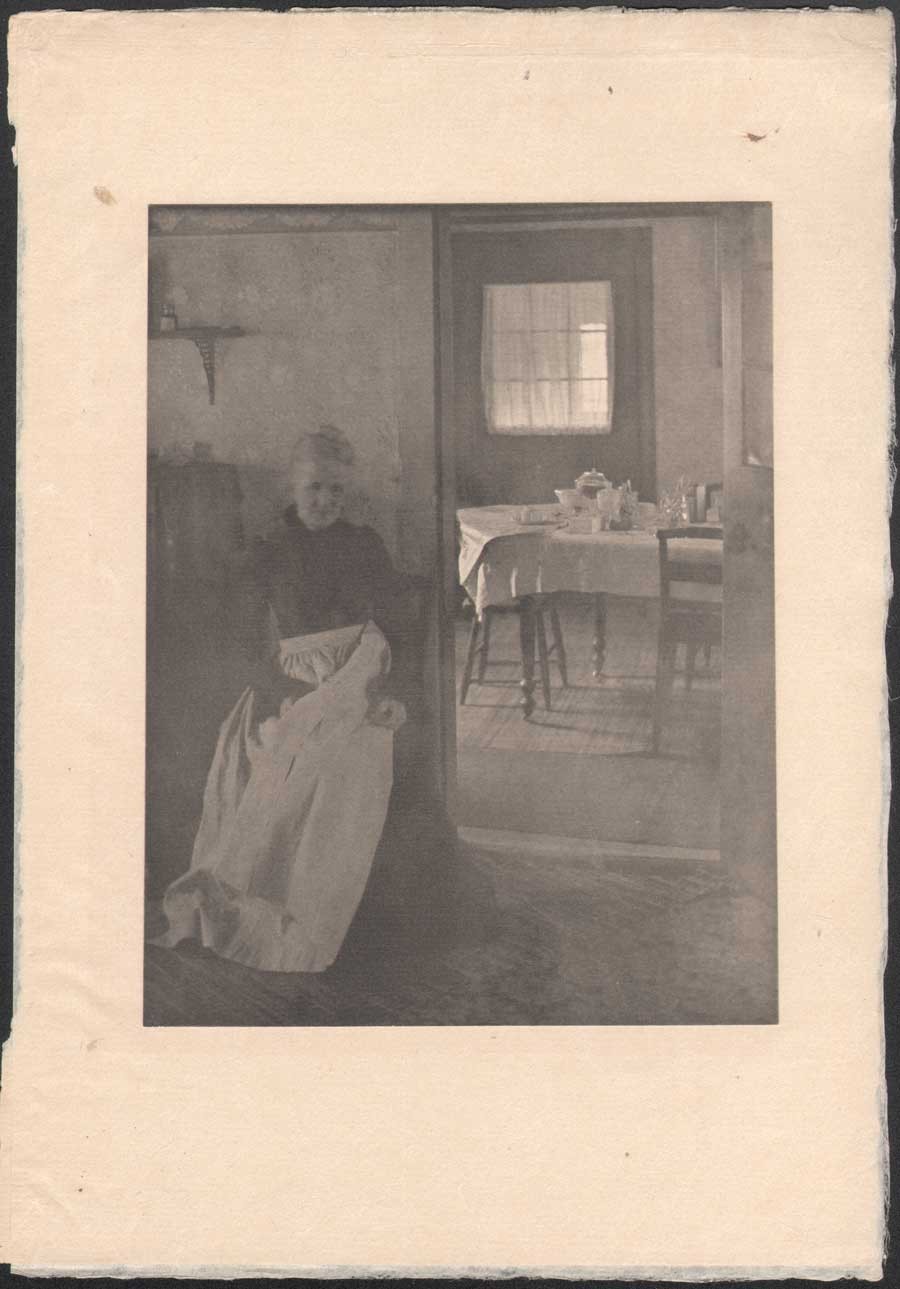
Clarence H. White: American: 1902: “Illustration to “Eben Holden”” (1903) hand-pulled photogravure: (tipped image:19.7 x 15.0 cm | Japan paper support: 30.5 x 21.0 cm) in: Camera Work III. (1903) Two plates in the Edition de luxe of Eben Holden: “How much was that a yard ?” (seen in this post-CW IX: 1905) and this one: “Mother was living in the old home alone”-an interior portrait of the photographer’s mother Phoebe Billman White (1845-1920) were also published as photogravures in Camera Work. From: PhotoSeed Archive
And later that year, citing White’s involvement with Eben Holden while writing in the Photographic Times Bulletin, Hartman brought up the potential financial rewards possible for pictorial photographer in this new field:
“The only way to approximate a market value of pictorial prints is to investigate how much they might bring on the average, if offered for sale as illustrations. There is lately a decided demand for photographic illustrations, and consequently a certain standard price in vogue. The pictorialist, of course, and perhaps with some right, aspires to illustrator’s prices (i.e., $50-$100 for the full page of a magazine), but he has never reached it, with the one exception of Clarence H. White, who is said to have received several hundred dollars for his series of “Eben Holden” illustrations.” (10.)
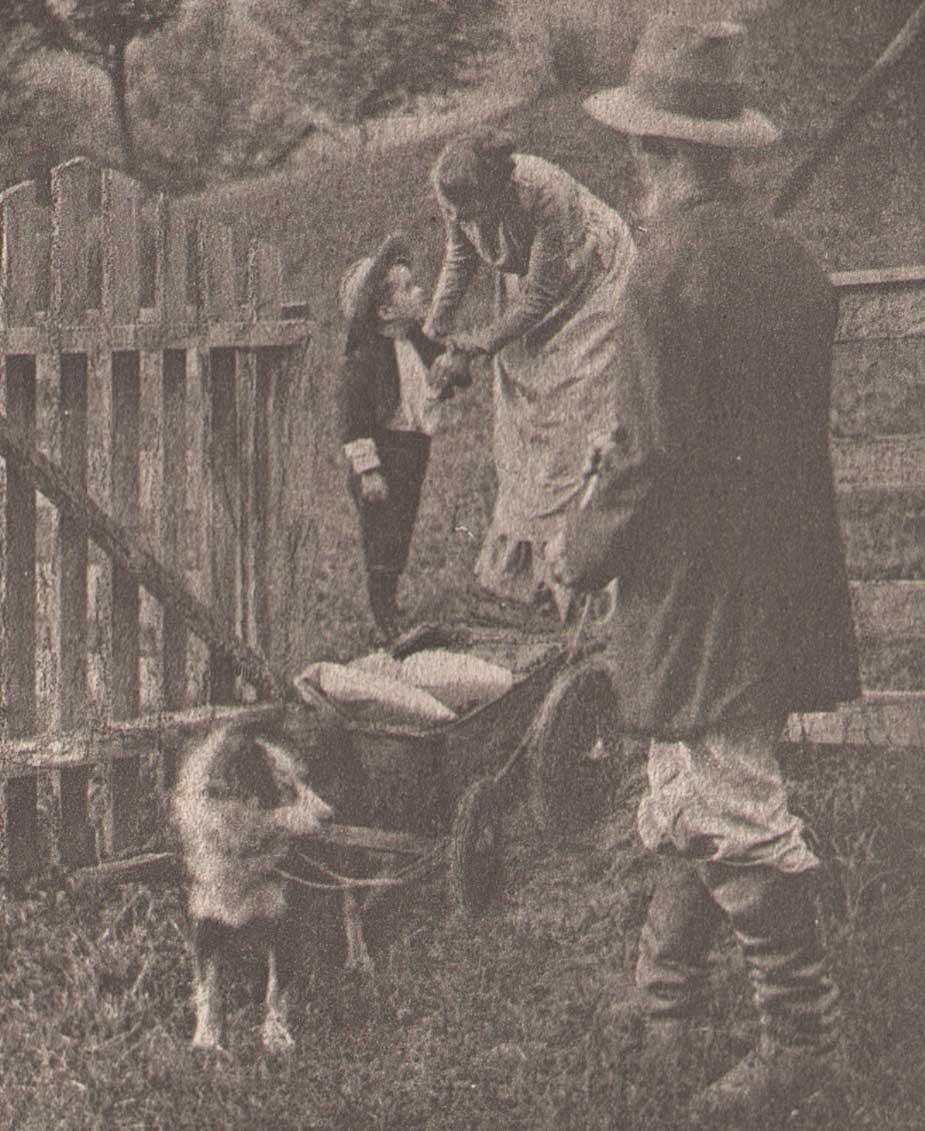
Detail: “Tucked some cookies into my pocket” : Clarence H. White: American: 1902: hand-pulled photogravure plate (11.9 x 7.3 cm) included with Edition de luxe of Eben Holden (1903): Lothrop Publishing, Boston. The young orphan William Brower is possibly modeled here by the photographer’s son Maynard Pressley White (b. 1896) and his wife Jane Felix. (1869-1943) The scene shows Brower preparing to head out into the wilderness in a dog-pulled cart with Eben Holden at right. From the novel: “Our hostess met us at the gate and the look of her face when she bade us good-by and tucked some cookies into my pocket, has always lingered in my memory and put in me a mighty respect for all women.” From: PhotoSeed Archive
This additional source of significant money to Clarence White and his young family through these illustration commissions invariably gave him additional confidence in his abilities as a photographer and financial peace of mind to eventually make his way to New York City, leaving Newark in 1906. It is also not a stretch to infer White’s own life mimicked the storyline of hard work that can earn the “American Dream” found between the pages of Eben Holden. Although the critic for the New York Times reviewing the play at New York’s Savoy theater didn’t care too much for the acting:
“As an exhibition of dramatic craft “Eben Holden” is hardly worth serious consideration“…
he did, a few paragraphs later, write the production had a few redeeming qualities:
But, despite its defects, the play is wholesome; it is redolent of the woods and the fields, and it provides the opportunity for an evening of entertainment that need not be looked back upon with regret. (11.)
No doubt Clarence White, had he been in attendance watching the play inside Newark’s Auditorium that 1904 November evening, would have agreed with these last sentiments of the big city critic, marveling and grinning to himself in the darkened hall while taking in the surreal juxtaposition that art imitating life can bring about.
Notes:
1. (White, Clarence H.) excerpt: An Annotated Bibliography on Pictorial Photography: Selected Books from the Library of Christian A. Peterson: Laurence McKinley Gould Library: Carleton College: Northfield, Minnesota: 2004
2. ABE listing: 120407. Besides multiple copies held by PhotoSeed, other known copies are in the Library of Congress, MOMA and Photogravure.com.
3. The Bookseller–Devoted to the Book and News Trade: Chicago: January, 1902: p. 28
4. Peter C. Bunnell: Inside the Photograph: writings on Twentieth-Century Photography: Aperture Foundation: 2006: p. 47
5. Clarence H. White : a personal portrait: Maynard Pressley White: Ph.D. dissertation, University of Delaware, 1975: pp. 79-80
6. see Beaumont Newhall’s Photography: A Short Critical History, from 1938, lists Eben Holden with the White illustrations as being published in 1903 on p. 215
7. excerpt: see Symbolism of Light: 1977: p. 7
8. Songs of All Seasons: Ira Billman: Indianapolis: The Hollenbeck Press: 1904: p. 65
9. excerpt: Advances in Artistic Photography: Sidney Allan: in: Leslie’s Weekly: April 28, 1904: New York: p. 388
10. excerpt: from: What is the Commercial Value of Pictorial Prints?: Sidney Allen: in: The Photographic Times Bulletin: December, 1904: p. 539
11. excerpt: review: “Eben Holden” at the Savoy: The New York Times, October 29, 1901
By all accounts, Scotsman David Octavius Hill, (1802-1870) Secretary of the Royal Scottish Academy of Fine Arts in Edinburgh, was an accomplished landscape painter. Thankfully, for the nascent medium of photography beginning around 1843, he is not remembered for that. Blame the Disruption, if you will.
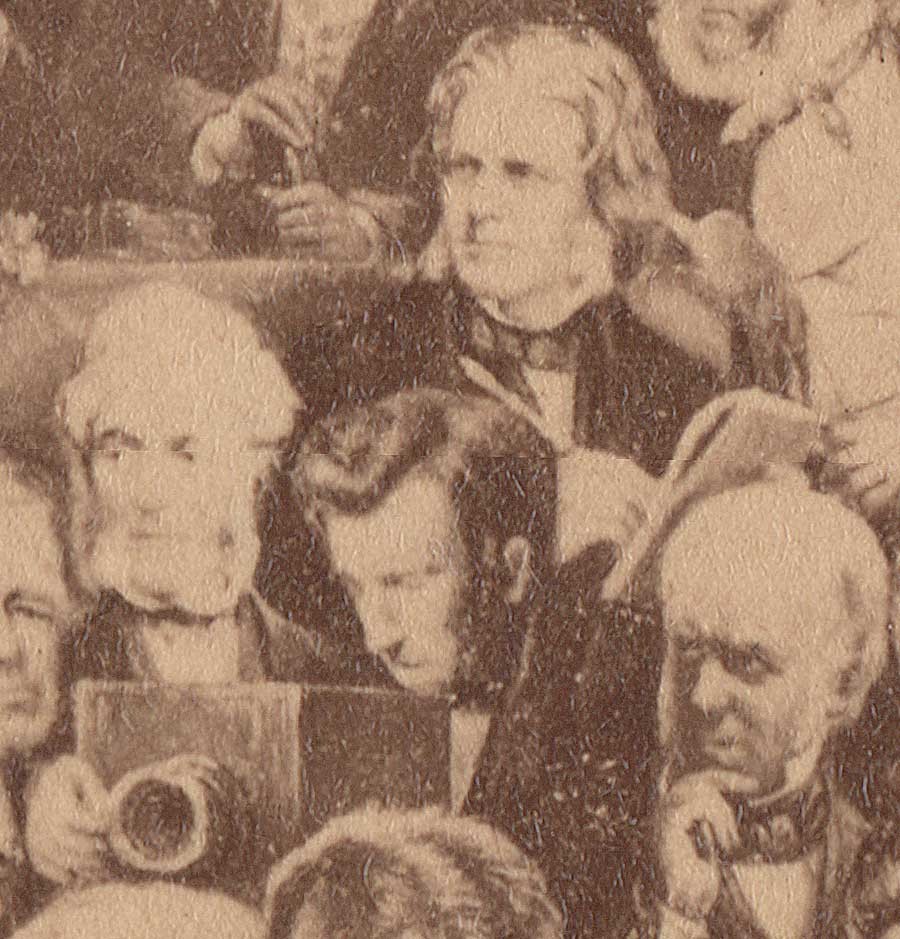
Detail: 1868: Artist David Octavius Hill with sketchpad at top; Photographer Robert Adamson behind wooden box camera at bottom. : Thomas Annan: vintage carbon copy photograph after D.O. Hill painting: “The Disruption of the Church of Scotland”completed 1866: original: (13.5 x 31.4 cm | 34.4 x 41.4 cm ) : from: PhotoSeed Archive
Disruption with a capitol D? He didn’t know it at the time, but when the freethinking Hill, a devout churchman seen above in detail in his own painting, sketchpad in hand, attended what became known as the Disruption: or, the historical occasion of Scottish religious free will known as the First General Assembly of the Free Church of Scotland signing the Act of Separation and Deed of Demission at Edinburgh’s Tanfield Hall, the artistic potential of photography would soon stake its’ own claim among the arts.
The Scots are Coming
Admittedly, the focus of this website doesn’t claim any great insights into the evolution of early photography, with the exception that certain photographers, those being the team of Hill and fellow Scotsman Robert Adamson, (1821-1848) popularly known as “Hill & Adamson”, are profoundly important to our understanding of artistic developments in relation to photography that came later in the 19th Century. Similar to the concept of how precedent by itself can build a case in the courtroom or in the more democratic court of public opinion, the reach of Hill & Adamson through their artistic achievement, especially in portraiture, impacted greatly the later working methods of many photographers and in particular, the eventual achievement of two fellow Scots who came into their orbit: Thomas Annan and his son James Craig Annan beginning around 1865 and in the early 1890’s.
As for that “Disruption” in relation to Hill’s completion 23 years later of an over-sized painting commemorating the event, the decision to separate from the accepted order gave former Church of Scotland congregations the freedom from central Church control to choose their own ministers, among other religious freedoms. For this alone, photography’s potential was nicely summed up in the London Art-Union journal in late 1869:
To photography Mr. Hill, soon after its discovery, about the year 1843, gave much attention, and we shall not be wrong in assigning him the credit of giving to the process its first artistic impetus; and, in conjunction with his friend, Mr. R. Adamson, of having produced many specimens of the Talbotype as yet unsurpassed for high artistic qualities. (1.)
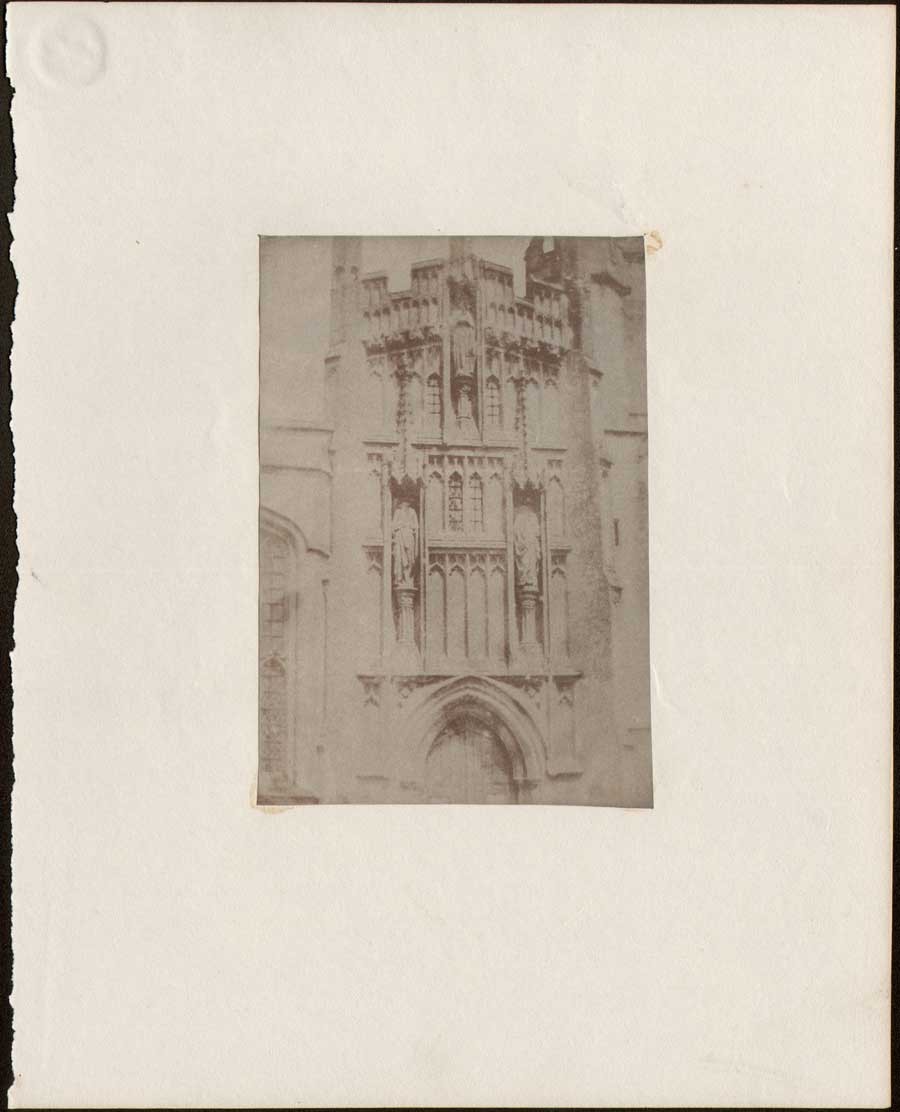
Example of vintage mounted salt print from calotype negative:(trimmed) : ca. 1845-1855: unknown photographer and location: detail from facade of English or Continental church building: ca. 1845-55: 12.8 x 8.8 | 24.9 x 19.9 cm: from PhotoSeed Archive
Thank the Calotype
Because the patent restricting Englishman William Henry Fox-Talbot’s 1841 invention of the Calotype process did not apply in Scotland, Hill & Adamson were able to exploit it to full potential. I’ve uploaded an example above, which in viewable form is technically known as a salted paper print from a calotype negative, for comparison. A survivor showing a bit of Gothic architectural detail, it was most likely done between 1845-1855 and found tucked between the pages of this archive’s copy of the aforementioned monthly Art-Union from 1846: the first magazine in history to publish (6000 copies) an example of a Talbotype “Sun Pictures” process calotype.
For a relatively clear understanding of what this early, yet cumbersome two-step process was, former George Eastman House Senior Curator of Photography William R. Stapp wrote in the pages of Image magazine from 1993 on the occasion of a seminal show of original Hill & Adamson calotypes held by the institution:
Calotypes are made on paper. The process requires the photographer to sensitize a sheet of good quality writing paper by brushing it with successive solutions of silver nitrate, potassium iodide, gallic acid, and silver nitrate. After being dried in the dark, the sensitized paper is loaded in the camera; after an exposure of several minutes, the negative is developed by brushing the paper with a solution of gallic acid and silver nitrate, fixed in a bath of sodium thiosulfate (“hypo”) to remove unexposed silver salts, and washed. When dried, this typically dense and contrasty negative is used to make a positive print on so called “salted paper,” which the photographer also has to prepare. This time a sheet of the same good quality writing paper is soaked first in a solution of sodium chloride (ordinary table salt, hence the term “salted paper”), then in a solution of silver nitrate, to produce the halide silver chloride. After it has been dried in the dark, the now light-sensitive salted paper is exposed to the negative in strong sunlight until the image is printed-out on it in deep orange hues. The resulting positive print is fixed in hypo, toned with gold chloride to a rich reddish-brown color, and washed to remove the residual chemistry. In all modern photographic materials, a transparent gelatin emulsion coated on the film or paper support contains the silver particles that form the image. Neither the calotype negative nor the calotype positive has an emulsion of any kind. The image resides literally within the fibers of the paper because the paper itself has been permeated with the photosensitive chemicals. A calotype print consequently incorporates the “tooth” (texture) of both the negative paper and the positive paper in its image. The print has a texture that is both visual and physical, which softens the image and mutes the rendition of detail. (2.)
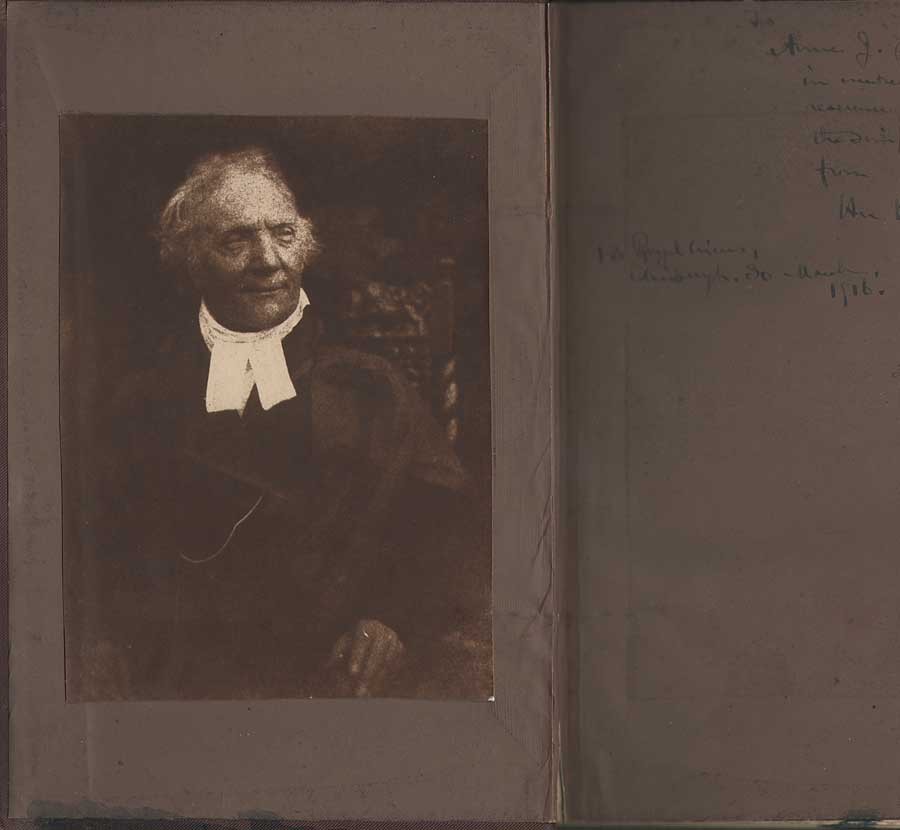
Pasted carbon print: ca. 1916: The Rev. Dr. Thomas Chalmers: (1780-1847) minister, social reformer, leader & first Moderator of the Free Church of Scotland Assembly, Principal of New College, Edinburgh.:15.2 x 11.1 cm: Jesse Bertram: after original ca. 1843 calotype by Hill & Adamson.: shown on opened, inside board cover to volume: “A Selection from the Correspondence of the late Thomas Chalmers, D.D. LL.D.” : Edinburgh: Thomas Constable and Co. : 1853: from PhotoSeed Archive
Activism, and a bit of Fate
As fate would have it, one of those involved with the Scottish Free Church movement was Fox-Talbot correspondent Sir David Brewster. A friend of “Disruption” general assembly moderator, the Rev. Dr. Thomas Chalmers, (1780-1847) who was a minister, social reformer and evangelical orator of high renown chiefly responsible for the secession from the established Church, Brewster early on had learned the Calotype process from his friend Talbot. Teaming with Saint Andrews University chemistry professor John Adamson, they in turn taught it to Adamson’s younger brother Robert Adamson in 1842 after he had moved to Edinburgh.
And the rest they say is history. With Brewster also present at the assembly signing with Hill, he in turn suggested the new process to the painter as a way to solve the dilemma of accurately portraying the hundreds of clergy and others present at the “Disruption” for posterity.
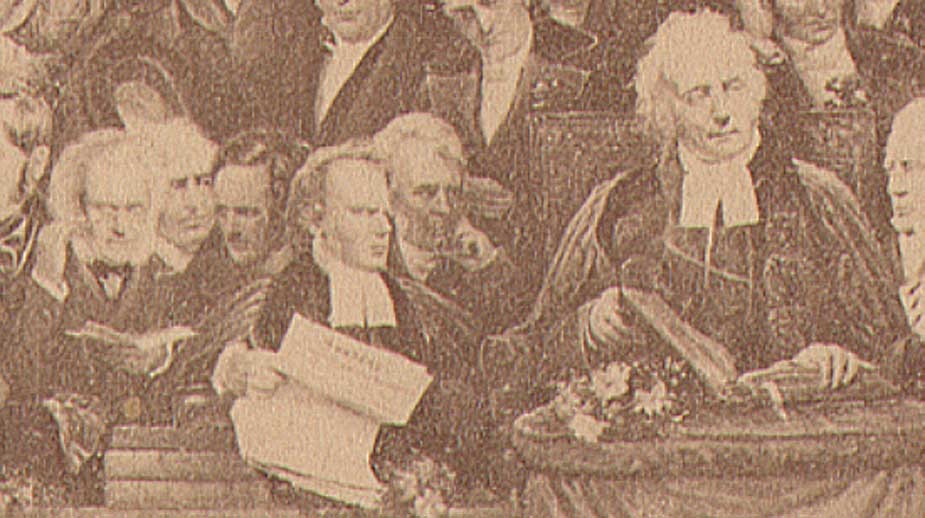
Detail: 1868: far right: Rev. Dr. Thomas Chalmers: Free Church of Scotland moderator along with major figures left to right: Scottish photography pioneer Sir David Brewster, (wearing spectacles looking down at book) Rev. Robert Lorimer, Rev. John Forbes, Dr. David Welsh: undivided Church of Scotland moderator holding a copy of May 18, 1843 church protest that was never answered, Dr. John Fleming, Chalmers. : Thomas Annan: vintage carbon copy photograph after D.O. Hill painting: “The Disruption of the Church of Scotland”completed 1866: original: (13.5 x 31.4 | 34.4 x 41.4 cm ) : from PhotoSeed Archive
Twenty-three years later, most likely with the help of Hill’s second wife Amelia Paton, (1820-1904) a sculptress, the Disruption painting, measuring in finished at over 11 feet by 5 feet, was ready for public display. And this is where it gets interesting for the career of Thomas Annan (1829–1887) and much later, his son James Craig Annan. (1864-1946) The decision to copy the painting for a mass audience was never in doubt for Hill, a man well-connected with the Scottish publishing trade who was born into it; his father being a bookseller and publisher. Hill had even learned the art of lithography from an early age, using it in the reproduction of his own work as a landscape painter for 20 years.
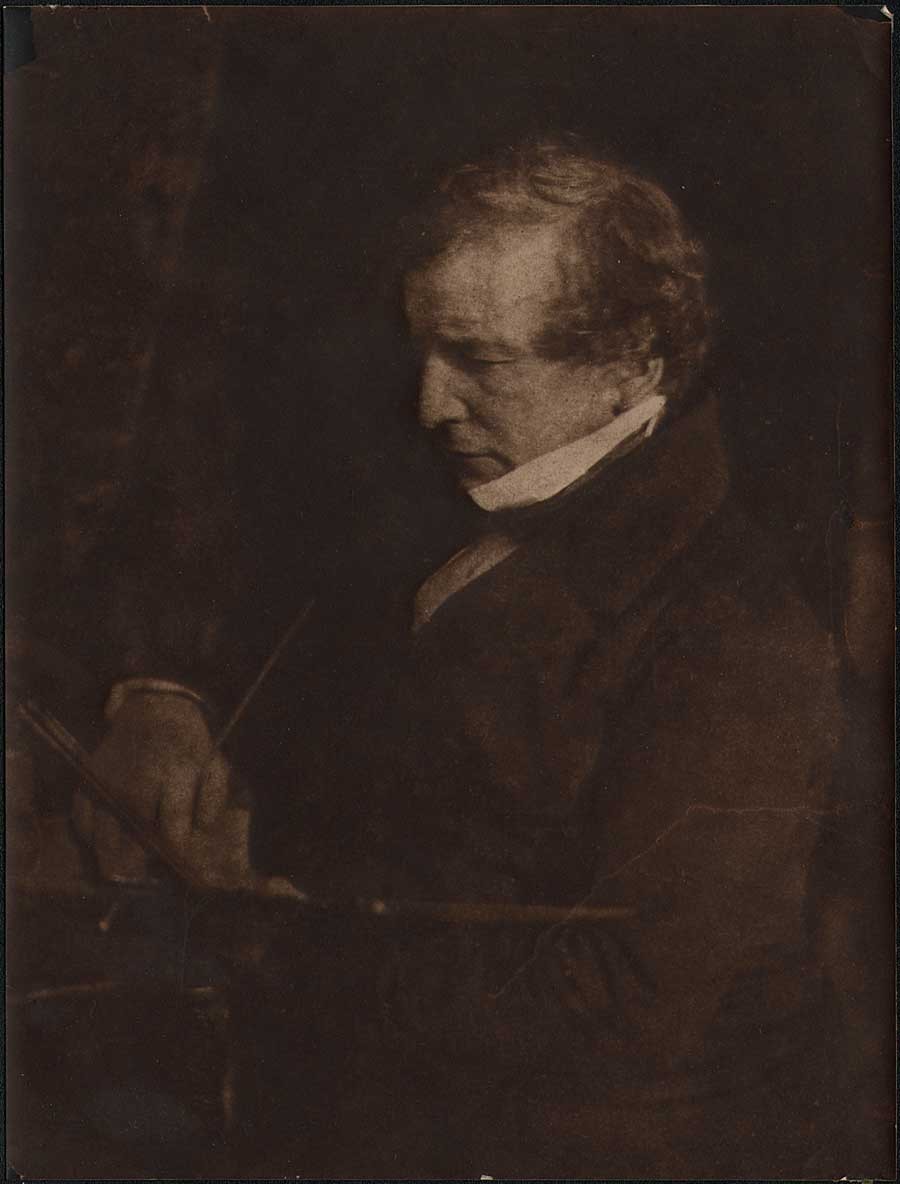
Carbon print: ca. 1879 – 1881 : William Etty, R.A. (English painter: 1787-1849) : Thomas Annan or James Craig Annan: after original 1844 calotype paper negative by Hill & Adamson: 18.5 x 14.0 cm: former collection: Exeter Camera Club: from PhotoSeed Archive
In 1865, shortly before his masterwork was finished, Hill made the acquaintance of Annan by reputation through his brother Alexander’s art gallery in Edinburgh. Annan’s copy paintings had been displayed there, for he had already made a name for himself in this line of work as early as 1862, producing fine copies of artwork for the Glasgow Art Union. These Art Unions “were lotteries connected with the major art exhibitions; the successful subscribers won paintings, and every subscriber received an engraving.” (3)
A commission resulted between Hill and Annan to copy Hill’s Disruption masterwork, a canvas that unfortunately- as opposed to the hundreds of Hill & Adamson calotypes used for reference works in its’ creation and now considered masterpieces of the photographic art-did not equate it to a masterpiece itself. Annan employed for this task an improved permanent carbon photographic process, using Joseph Wilson Swan’s 1864 patent carbon tissue to reproduce copies of the “Disruption” after purchasing the Scottish rights from him in 1866. (4.)
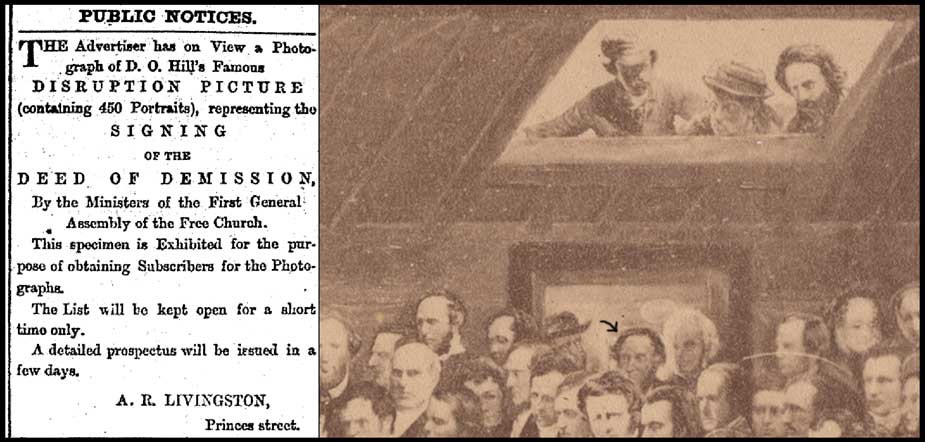
Left: 1868: advertisement: New Zealand bookseller A.R. Livingston’s solicitation for Thomas Annan carbon photo of “Disruption Picture” completed 1866 by D.O. Hill: published in Otago Daily Times. Right: 1868: Detail: black arrow pointing to Thomas Annan standing in doorway painted as part of “Disruption” painting (another account states Annan is at left of this figure wearing hat) : Thomas Annan: vintage carbon copy photograph after D.O. Hill painting: “The Disruption of the Church of Scotland”completed 1866: original: (13.5 x 31.4 | 34.4 x 41.4 cm ) : from PhotoSeed Archive
In addition to several detail photos of the painting included with this post, a mounted carbon copy photograph by Annan published in 1868 for the 25th anniversary of the signing of the Act of Separation and Deed of Demission can be seen in our archive here. For those adventurous enough to decipher names and titles of some of those making up the sea of faces in the painting, partly seen below, a fascinating, yet tricky key to some of the major figures can be found here. This was published as part of the 1943 centenary volume The Disruption Picture: A Memorial of the First General Assembly of the Free Church of Scotland by Donald MacKinnon. (5.)
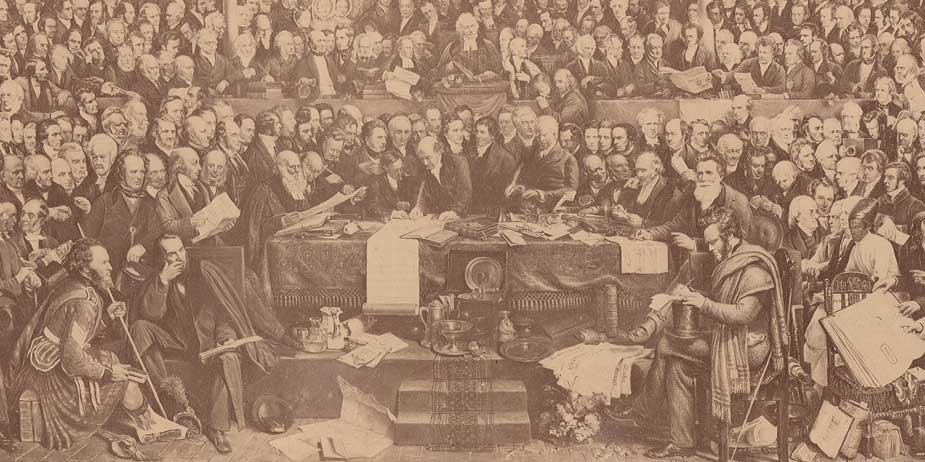
Detail: 1868: At center of table, the Rev. Dr. Patrick MacFarlan (1781-1849) of Greenock is first to sign the “Deed of Demission”, “resigning the highest living in the Church of Scotland at the time”, said to be £ 1000.00 annually, which commemorated the establishment of the Free Church of Scotland: Thomas Annan: vintage carbon copy photograph after D.O. Hill painting: “The Disruption of the Church of Scotland”completed 1866: original: (13.5 x 31.4 cm | 34.4 x 41.4 cm ) : from PhotoSeed Archive
Thomas Annan, Documentarian
With Hill’s work complete, Thomas Annan’s professional career was starting to hit full stride, especially after his success with the Disruption commission. In 1868, the same year a version of this carbon photo was published, (6.) Annan undertook a new commission from the City of Glasgow Improvements Trust that when first published as a series of around 35 albumen prints in 1872, became known as The Old Closes & Streets of Glasgow. As previously outlined in my essay written in 2006 for the Luminous Lint website, Annan’s photographs taken between 1868-1871 are among the earliest done specifically for a record of slum housing conditions prior to urban renewal and as such are an important milestone in the history of documentary photography. (7)
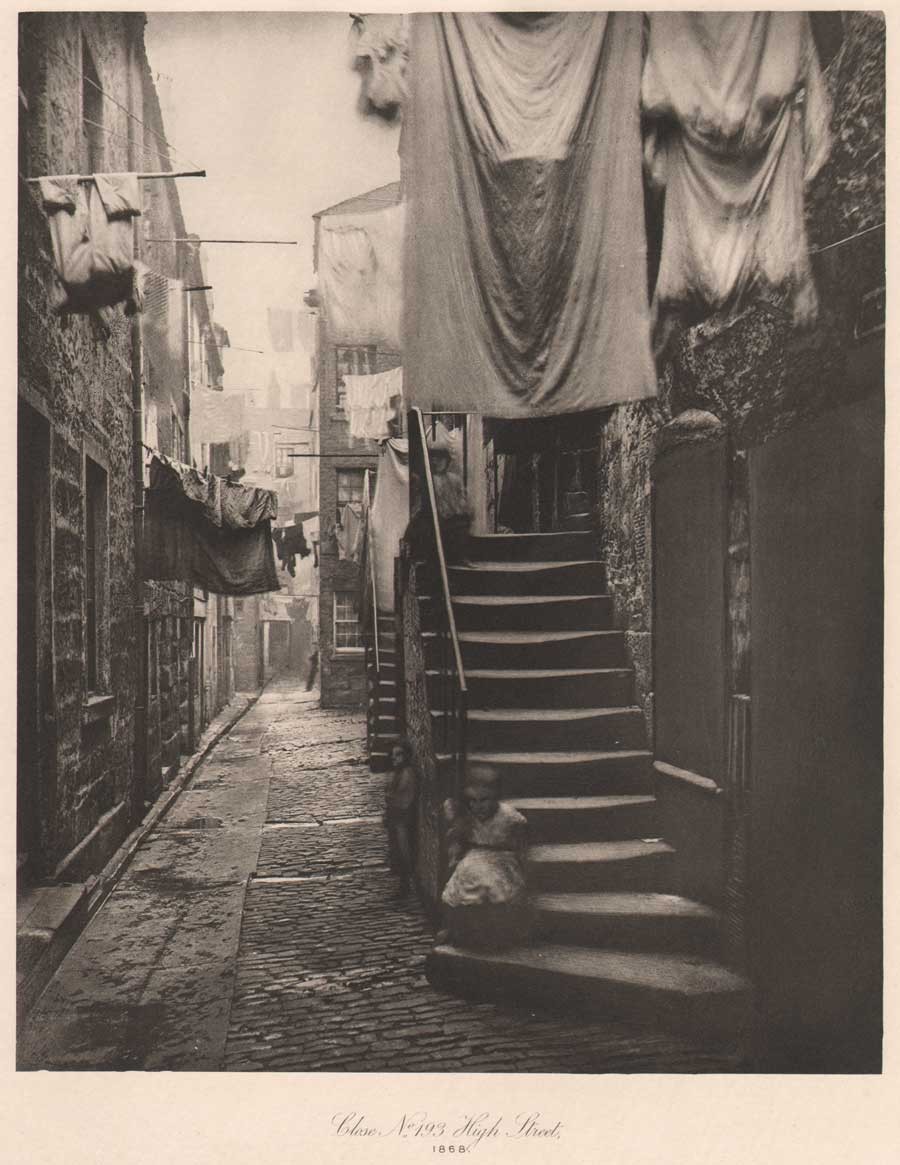
1868: vintage hand-pulled photogravure: “Close No. 193 High Street”: Thomas Annan: from: “The Old Closes & Streets of Glasgow” – photographs taken for the City of Glasgow Improvements Trust : 22.2 x 18.1 | 38.0 x 28.5 cm: 1900: gravure from original collodion glass plate by James Craig Annan: Glasgow: plate #9 from James MacLehose & Sons limited edition of 100: from PhotoSeed Archive
Perhaps knowing her husband’s photographic legacy might be carried on, Amelia Paton bequeathed to Annan “a large collection of calotypes and the portrait lens used by Hill and Adamson” after Hill’s death in 1870. (8.) Speculation he used this very lens for portraits taken soon after for his illustrated volume the Memorials of the Old College of Glasgow, (1871) with examples seen in this post, are an intriguing insight raised by Sara Stevenson in her biography of Annan. (9.) Proportionally, individual portraits taken by Hill & Adamson in the 1840’s compared with those by Annan of the professors from the Glasgow volume and are very similar. However, Annan had the advantage of using the collodion process as opposed to calotype, with the increase of sensitivity of these plates lending a sharpness to his work not possible as movement was often the inevitable result of the slower 2-3 minute exposures required for the older process.
A comparison showing the softness, beauty and masterful composition of a later generation carbon print portrait of English painter William Etty (1787-1849) done ca. 1843 by Hill and Adamson can be seen with this post along with portraits by Annan taken around 1870. These include the striking portrait of professor and theologian John Caird (1820-1898) that reveal compositional similarities between the photographers nearly 30 years apart. With the archival benefit of Annan printing his efforts in permanent carbon, it’s also amusing to see exposure times, although shorter than calotype, did not prevent him in at least one case from seizing the moment in order to permanently memorialize his subject and another unwitting one: a rather large housefly clinging to academic robes worn by University of Glasgow English Language and Literature Professor John Nichol.
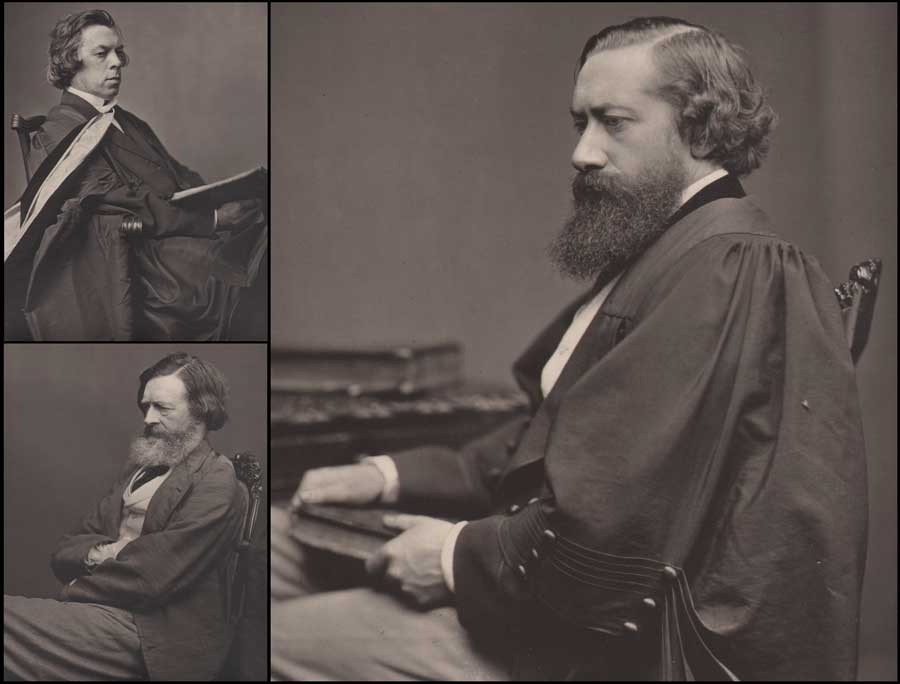
1871: Thomas Annan: mounted carbon portraits from”Memorials of the Old College of Glasgow”(each cropped) : all portraits 21.5 x 16.4 | 36.5 26.0 : upper left: Professor of Divinity John Caird (1820-1898) : lower left: Professor of Greek Edmund Law Lushington (1811-1893) : right: Regius Professor of English Language and Literature John Nichol (1833-1894) (note housefly on academic robe at right below chair back) : from PhotoSeed Archive
Besides University professors, Annan did many fine portraits of Free Church of Scotland ministers in addition to ministers, elders and missionaries affiliated with the United Presbyterian Church. A unique album of these portraits, reproduced in Woodburytype, is held by this archive, with several appearing in the 1875 Annan published volume Historical Notices of the United Presbyterian Congregations in Glasgow. As a businessman running a commercial studio, Annan marketed many of these images, often as variants, in the carte de visite format. The following is a listing of Annan’s Scotland studios with dates supplied by Peter Stubbs of the EdinPhoto web site:
202 Hope Street, Glasgow: 1862-72
77 Sauchiehall St. Glasgow: 1873-74
153 Sauchiehall St. Glasgow: 1875-91
75 Princes St. Edinburgh: 1876-82
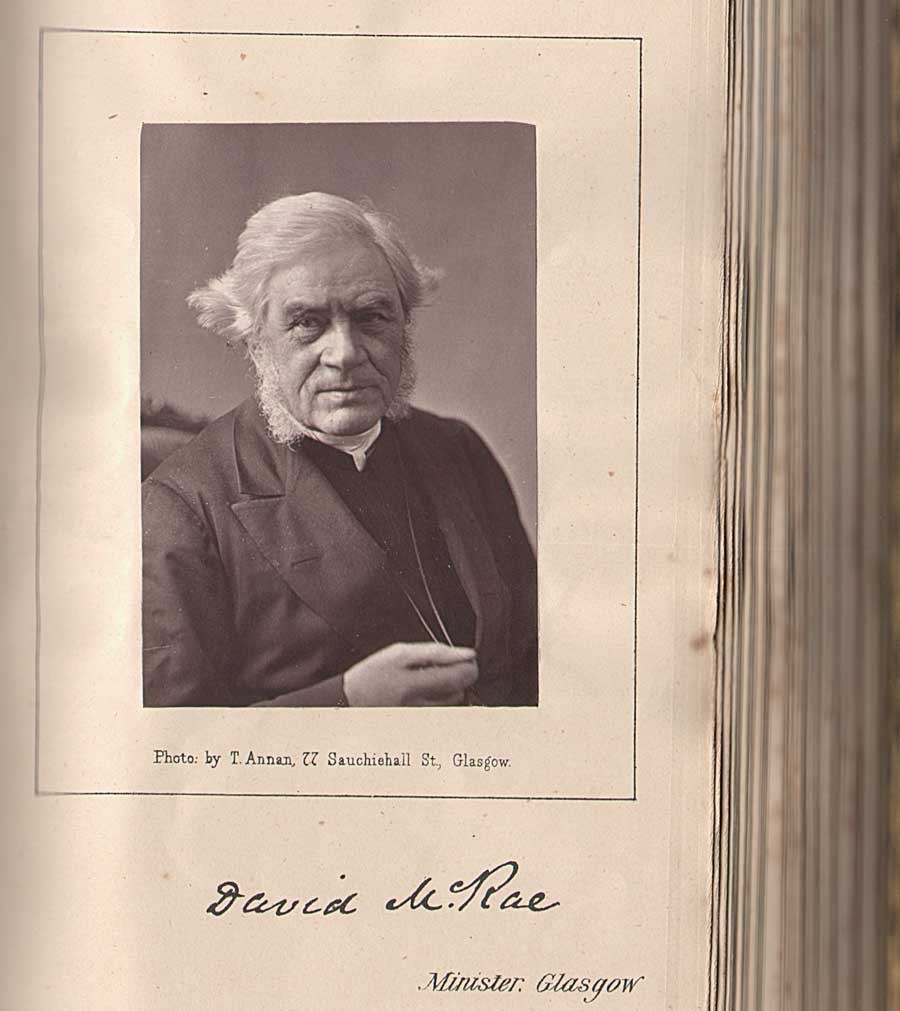
1873-74: Rev. David McRae of Glasgow: (a leading temperance movement leader from the 1850-70’s) mounted Woodburytype portrait with facsimile autograph: Thomas Annan: 8.3 x 5.6 | 19.4 x 10.5 cm : from unique folio album of nearly 60 Woodburytype photographs taken ca. 1862-1882 by Thomas Annan and most likely John Annan of ministers, elders and missionaries affiliated with the United Presbyterian Church: from PhotoSeed Archive
Coming full-circle: Learning Photogravure
In 1883, after purchasing the British rights to a new process of Photogravure invented by Czech artist Karl Klíc, (1841-1926) Thomas Annan and son James Craig Annan traveled to Vienna in order to personally learn its intricacies. As defined by our good friends over at Photogravure.com, Klíc’s 1879 refined process of “reproducing a photograph by printing on paper from an inked and etched copper plate” was a vast improvement over that of William Henry Fox Talbot’s 1858 patented Photoglyphic Engraving process. Thomas Annan was so smitten he wrote Klíc the following appreciation:
“I beg to express my entire satisfaction with your gravure process… The process itself is very valuable to a fine art publisher because of the beauty of the work and the crafted manner in which the plates are executed. With many thanks to me and my son I remain, Dear Sir, yours very truly” – Thomas Annan March 11, 1883 (10.)
Fittingly renamed the Talbot-Klíc Dust Grain Photogravure by Klíc, the process was soon fully embraced by Annan’s publishing concerns, T. & R. Annan and Sons of Glasgow, Hamilton and Edinburgh, who utilized photogravure for high-quality, fade-resistant and archival plates, mostly copies of original works of art, an established specialty. Soon, the new process, which involved the individual hand-pulling of plates from a copper-plate press, was further exploited and refined by the budding photographer James Craig Annan in the early 1890’s, whose original photographic negatives “from nature” during his travels to the Continent, particularly North Holland and Italy, were directly reproduced in gravure after an ongoing period of great experimentation and refinement.
Like his father Thomas, who reproduced and exhibited some of the Hill & Adamson calotypes in carbon during the 1870’s and early 80’s using his own refinements of Swan’s process, (11.) James Craig Annan fully embraced Talbot-Klíc gravure printing to reinterpret their landmark achievements in early pictorial portraiture as well as other studies including the fisherfolk of Newhaven near Edinburgh. In this regard, beginning as early as 1890, Annan produced a series of hand-pulled gravures re-photographed from the original Hill & Adamson paper calotype “negatives in the possession of Andrew Elliott.” (12.) Later in 1905, working as part of the T & R Annan firm of Glasgow, he produced a further series of 20 plates printed on Japan tissue. (13.) These copper plates were then re-used for a series of gravures published in Alfred Stieglitz’s Camera Work XI, (1905) XXVIII, (1909) and XXXVII, (1912) thereby introducing new generations to the masterful legacy left by Hill & Adamson.
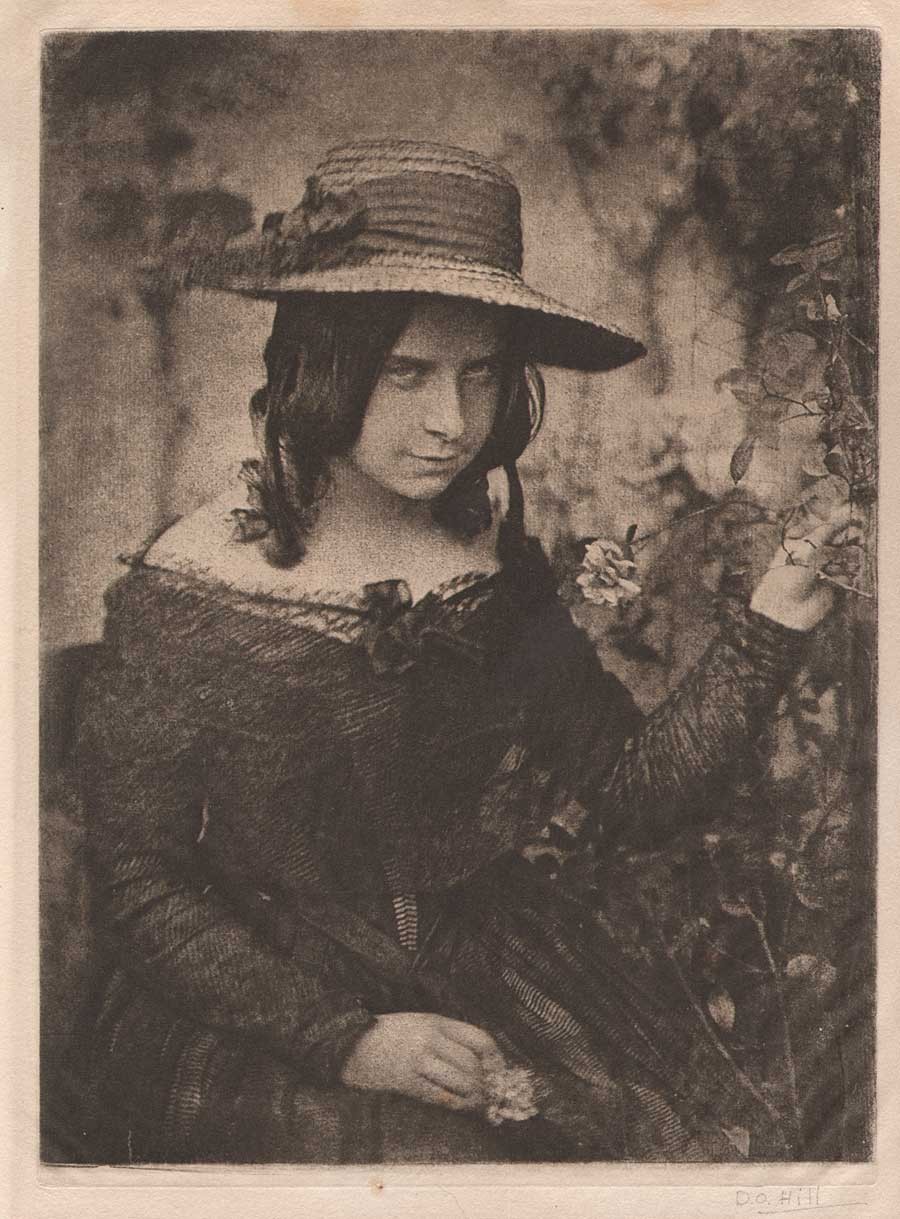
1890-1912: “Girl in Straw Hat” (Miss Mary McCandlish) : vintage hand-pulled photogravure trimmed and mounted within cream paper folder: possibly a 1912 Camera Work proof: 21.5 x 15.9 |25.5 x 19.0 cm: James Craig Annan after original paper calotype ca. 1843-47 by Hill & Adamson: reproduced in CW XXXVII: originally in Margaret Harker Collection: from PhotoSeed Archive
I’ll end this lengthy post with an excerpt from an appreciation of D.O. Hill by James Craig Annan, who was fortunate to have met and been inspired by the artist when he was only six years old- the result of his father being an intimate friend of Hill. This was included as part of a larger essay he wrote on the Scottish pioneer for Camera Work XI, and he makes the strong case their achievement was a direct result of their portrait collaborations for the Disruption painting:
“Thus the partnership began which was to produce the noble and extensive series of portraits which for powerful characterization and artistic quality of uniformly high excellence have certainly never been surpassed and possibly not even rivaled by any other photographer. This may seem an extravagant appreciation of Hill’s work, but it has been arrived at after mature deliberation.” (14.)
-David Spencer
Notes:
1. British Artists: Their Style and Character: With Engraved Illustrations. : David Octavius Hill, R.S.A.: in: The Art-Journal: London: October 1, 1869: p. 317
2. William F. Stapp.: Hill and Adamson: Artists of the Calotype: from: Image: George Eastman House: Spring/Summer: Vol. 36: No. 1-2: 1993: p. 55
3. Sara Stevenson: Scottish Masters 12: Thomas Annan: National Galleries of Scotland: 1990: p. 5
4. After discussions with Hill, the copy photograph of the “Disruption“canvas was taken by Thomas Annan after he had ordered “a large Photographic Camera of the latest and most perfect construction” from Dallmeyer: in: 1866 Disruption prospectus by Hill: published in: Scottish Masters 12: p. 7
5. Alan Newble has thoughtfully, and no doubt, painstakingly, compiled the key as part of his website, with further insights on the historical importance of the Rev. Dr. Thomas Chalmers.
6. In correspondence between Annan and Hill in late December, 1865, Hill stated he wanted the Disruption painting reproduced in thousands of photographs in 3 separate sizes. “He (Hill) was hoping for prints half the size of the painting, and suggested that Annan make them in three parts, joining them together around the figures rather than in an arbitrary straight line.” : from: Hill & Annan letters: quoted in: Scottish Masters 12: pp. 6-7. Alas, Hill’s desires were trumped by technical limitation, with carbon prints supplied by Annan printed in 1866 in 3 sizes, as stated in the Photographic News of London: “Photographs of the picture will be issued in three sizes, ranging from 24 inches by 9 inches to 48 inches by 21 1/4 inches, at prices ranging from a guinea and a half to twelve guineas.”
7. The carbon print edition of Old Closes first appeared in 1877, with two later photogravure editions featuring 50 plates each printed by James Craig Annan published in 1900. Fine examples of the albumen prints from Old Closes can be found along with superb background on their making at the University of Glasgow Library special collections department online resource found here.
8. cited in Scottish Masters 12: p. 8
9. Ibid: p. 13
10. from: Photogravure.com online resource accessed August, 2014. While in Vienna under Klíc’s watchful eye, the Annans had produced a photogravure of Noel Paton’s painting of The Fairy Raid.
11. Scottish Masters 12: p. 8
12. David Octavius Hill & Robert Adamson: in: The Collection of Alfred Stieglitz: Weston Naef: New York: The Metropolitan Museum of Art: p. 378. Elliott, (1830-1922) was a nephew of D.O. Hill
13. Ibid, p. 378
14. excerpt: David Octavius Hill, R.S.A. 1802-1870.: J. Craig Annan: in: Camera Work XI: New York: edited and published by Alfred Stieglitz:1905: p. 18

“Souvenir De Londres” From the Original Photograph by Leonard Misonne: vintage screen gravure four-fold holiday card: image: 10.5 x 14.2 cm: frame: 14.3 x 18.4 cm: sheet: 28.5 x 36.6 cm: atelier: J. Arthur Dixon | Isle of Wight: MXL /73 circa 1930-1940
Beyond the Tweets, texts and messaging saturating our present-day social media culture-recently extending even to software giving a smartphone user the ability to view a photograph just once before it disappears into the ether forever, (Snapchat et al apps) the endurance, value and cultural importance of the printed word and photograph need be considered-indeed marveled at-for the historical record and of course for posterity itself.

“The Little Country Paper”: vintage cyanotype postcard (recto) with inked handwriting posted October, 1906 from Lisbon, New Hampshire to Littleton, N.H. by Arthur W. Buffington (b. 1868) to his son Harold A. Buffington (1886-1976) : 8.8 x 13.9 cm: image: 6.8 x 5.0 cm: PhotoSeed Archive
Consider today’s example, a postcard featuring an original cyanotype photograph of a well-dressed gentleman reading a newspaper. Addressed and posted to Harold A. Buffington of Littleton, New Hampshire in October, 1906, (1.) this simple and lasting form of communication is signed “Papa”, (2.) with the suggestion for his son to come over on Sunday for a visit in order to enjoy a slice of pumpkin pie.
Before getting to the nut graph as they say in newspaper lingo, “Papa”: aka Arthur W. Buffington, (b. 1868) begins his correspondence with a quote from a well known (at least for its time) story celebrating the importance of small town rags everywhere. It might not be surprising given his listed occupation as a printer for the 1900 U.S. Census. Owner of the Buffington Press in Littleton during this period, (they printed cookbooks among other volumes) he writes on the postcard:
The Little Country Paper
It tells of all the parties an’ the balls of Pumpkin Row‘Bout who’s spent Sunday with who’s girl, an’ how the crops’ll grow.An’ how it keeps a feller posted ‘bout who’s up and who’s down.That little country paper from his ol’ Home Town.
This entire “story” seems to have originated around 1903 or before by someone writing for the Denver Post newspaper in Colorado. I’ve taken the liberty to include it in its entirety at the end of this post (as it originally appeared) along with another similarly titled “story” I discovered from the era . And the juicy part? “Papa” writes:
Come down Sunday. Mamma has made a whole pumpkin pie and I have only had one piece out of it. (you can divide your piece with L. O and mamma and Ray don’t like punkin very well!) Papa.
In addition to the slice of pie he presumably ate, the postcard might have even inspired Harold Buffington to get ink in his blood like his father, for he is listed in the 1940 U.S. Census as a printer for the Courier office, still known today as the Littleton Courier, a weekly newspaper published since 1889.
The Little Country Paper
When the evenin’ shades is fallin’ at the endin’ o’ the day, An’ a feller rests from labor, smokin’ at his pipe o’ clay. There’s nothin’ does him so much good, be fortune up or down, As the little country paper from his O’l Home Town.
It ain’t a thing o’ beauty an’ its print ain’t always clean. But it straightens out his temper when a feller’s feelin’ mean. It takes the wrinkles off his face an’ brushes off the frown. That little country paper from his Ol’ Home Town.
It tells of all the parties an’ the balls of Pumpkin Row. ‘Bout who spent Sunday with who’s girl an’ how th’ crops’ll grow. An’ how it keeps a feller posted ‘bout who’s up an’ who is down. That little country paper from his O’l Home Town.
Now, I like to read the dailies an’ the story papers too. An’ at times the yaller novels an’ some other trash—don’t you? But when I want some readin’ that’ll brush away a frown I want that little paper from my O’l Home Town. (3.)
The following with the same title originated in the Baltimore (MD) American newspaper in 1900 or before, and may have inspired the Denver Post account of The Little Country Paper:
The Little Country Paper
It’s just a little paper-it isn’t up to date:
It hasn’t any supplement or colored fashion plate.
It comes out every Friday, unless the forms are pied;
The outside is home printed, with boiler-plate inside.
It hasn’t any cable direct from old Bombay,
But it says that “Colonel Braggins is in our midst to-day.”
It doesn’t seem to worry about affairs of state.
But tells that “Joseph Hawkins has painted his front gate.”
It never mentions Kruger or Joseph Chamberlain.
But says that “Thompson’s grocery has a new window pane.”
And that “the Mission Workers will give a festival.
And there’ll be a temperance lecture in William Hooper’s hall.”
It tells about the measles that Jimmy Hankins had.
And says that Israel Johnson “has become a happy dad.”
It says that “cider-making is shortly to commence.”
And cites the fact that Ira Todd is building a new fence.
It mentions Dewey’s coming in one brief paragraph, And says that “Charlie Trimble has sold a yearling calf.” And everything that happens within that little town The man who runs the paper has plainly jotted down.
Some people make fun of it, but, honestly, I like To learn that “work is booming upon the Jimtown pike.”
It’s just a little paper—it hasn’t much to say—
But as long as it is printed I hope it comes my way. (4.)
-30-

Printed postcard (verso) addressed to Harold A. Buffington, Littleton, New Hampshire: 8.8 x 13.9 cm: Posted: Lisbon, N.H., October 1906: PhotoSeed Archive
Notes
1. It is believed the gentleman in the cyanotype photograph reading the newspaper is also the recipient of the postcard: Harold A. Buffington, a student who would have been 20 years old in 1906. (b.: September 12, 1886 | d. March, 1976. source: Crestleaf)
2. “Papa” was Arthur W. Buffington (b. 1868) who lived in Lisbon, New Hampshire at the time he mailed this postcard
3. The Little Country Paper: Denver Post: reprinted in the Mansfield (OH) News: Saturday, October 24, 1903
4. Newspaper Verse: Selections Grave and Gay: Current Literature-A Magazine of Record and Review: New York: Vol. XXVIII: April-June, 1900: pp. 192-93